Abstract
The air conditioning demand varies significantly in the hot and desert climates of the UAE due to diurnal temperature variation, seasonal shifts, and occupancy patterns. One of the challenges faced by the relatively higher energy-consuming UAE building stock is to optimize cooling capacity utilization and prevent excessive energy loss due to undesired cooling. A potential route to achieving such a goal involves cooling energy storage during low demand and releasing the stored cooling at peak demand times via thermal energy storage (TES). Latent heat thermal energy storage (LHTES) employing phase change materials (PCMs) provides impactful prospects for such a scheme, thus gaining tremendous attention from the scientific community. The primary goal of the current article is to provide a comprehensive state-of-the-art literature review on PCM-based TES for cooling applications to understand its efficacy, limitations, and future prospects. The article involves various applications, designs, and validations. The article emphasizes the importance of material innovations and heat transfer augmentation strategies to render this technology feasible for real-life integration into cooling systems.
1. Introduction
The unsustainable nature of fossil fuels and the associated release of greenhouse gas emissions are major concerns facing the future existence of traditional energy sources [1]. In an attempt to limit the environmental impact caused by fossil fuels, the Paris Agreement was incorporated, aiming to reduce the world’s CO2 emissions by 45% by 2030 from their 2010 levels and render the planet carbon neutral by 2050 [2]. While producing 80% of the global gross domestic product, cities currently account for 70% of all energy-related CO2 emissions, which may further aggravate the situation with rapidly increasing urbanization [3,4]. The future risk is evidently recorded by increased air pollution in urban areas compared with rural areas, which causes 6.5 million premature deaths globally, making air pollution the fourth most significant risk to human health [5,6].
Buildings currently account for 25% to 30% of all energy use, leading to substantial carbon emissions that are well on their way to 50% over the next three decades, stressing the need to improve their energy efficiency [7,8]. According to the findings, space heating and cooling demand accounts for approximately 75% of all energy utilized in single and multi-family homes [9], which may increase threefold over the next three decades, demanding immediate energy efficiency interventions to mitigate the risk of which reducing peak time energy demand through TES seems very promising [10,11,12,13]. Anticipated cooling demand has been presented in Figure 1 [12].
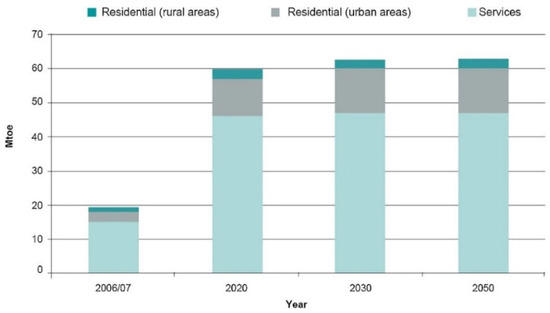
Figure 1.
Anticipated Cooling Demand in Europe, reproduced with permission of [12], Elsevier, 2016.
TES integrated into building skin can significantly enhance building thermal mass, resulting in up to a 30% reduction in heating and cooling demand [14]. PCMs employing latent heat storage at a relatively narrow temperature range have been extensively incorporated in cooling systems, textiles, construction materials, temperature-sensitive materials, and cooling electronic devices [15,16]. Multiple studies have examined PCM’s potential to control indoor comfort for heating and cooling applications, with promising initial findings pending several research issues to be resolved. The research issues requiring further investigations are the optimal selection of PCMs for a particular application, the low rate of heat transfer, and volume changes during the melting and freezing cycles that affect storage system design and capacity. Several approaches to augment heat transfer have been investigated, including encapsulating PCMs with nanoparticles, metal foam, fin arrangements, and an expanded graphite matrix [12,14,15,16,17].
TES in buildings is essential for demand management, as highlighted by Durakovic et al. [18]. Their study emphasizes the need for customized management strategies based on building types to improve energy efficiency. Key advantages of TES include significant energy savings, the elimination of supply-demand discrepancies, the potential for large-scale energy substitutions, and the requirement for coordinated efforts across energy sectors to optimize storage benefits [19]. PCMs find diverse applications in building structures, including bricks, wallboards, façade elements, floors, ceilings, roofs, and glazing, and offer promising potential due to their reversible properties and lightweight characteristics [20,21,22]. In another approach, heat storage modules based on PCMs were employed with flat-plate solar collectors to enhance thermal efficiency [23,24].
Several reviews on PCMs have been produced, dealing with the selection and encapsulation of PCMs in hot climates [25], synthesis and manufacturing technologies for encapsulated PCMs [26], integration of PCMs into solar thermal systems [27], and methods to enhance the thermal conductivity of PCMs [28]. None of the recent reviews provides a detailed insight into the PCM-based TES systems in the built environment as a means of cooling load reduction and peak shifting, which is being addressed by this article. The review aims to explore the effectiveness, limitations, and prospects of PCM-based TES technology, discussing their applications, designs, and performance coupled with efficiency improvement strategies.
The review paper is structured into six sections, providing insights into PCM selection criteria, applications for cooling buildings, heat transfer augmentation, and TES approaches. To improve the readability of this paper, a list of abbreviations is shown in Table 1.

Table 1.
Abbreviations and meanings.
2. PCM Selection Criteria for Hot Climate
The selection of a PCM plays a crucial role in cooling applications for buildings in hot climates. It depends on multiple factors, with the melting temperature range being the primary factor to be considered. The PCM should ideally melt during the daytime, absorbing heat, and solidify at night, releasing the stored heat and completing one cycle of thermal energy storage. The UAE experiences a hot and arid climate characterized by high temperatures and humidity. During the peak summer months of May to August, temperatures can reach extreme levels, with maximums reaching 49 °C and average temperatures ranging from 34 to 39 °C. Daytime temperatures typically range from 40.5 to 43 °C, while nighttime temperatures range from 31 to 35 °C. For the selection of PCM, it is recommended that the melting temperature be higher than the highest nighttime temperature to ensure complete PCM solidification passively at night [29,30], as reflected in Figure 2 [30].
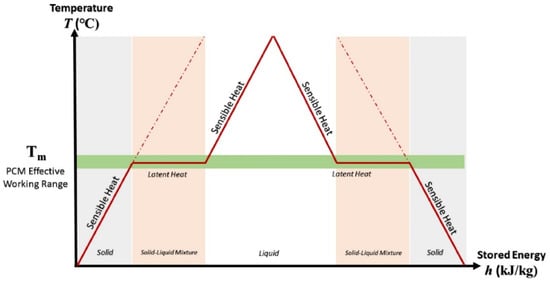
Figure 2.
T-h diagram of Solid-liquid and Liquid-solid phase change transition of PCMs, reproduced with permission of [30], Elsevier, 2020.
Other than the temperature factor, higher thermal conductivity and latent heat storage capacity are required of PCMs for the design of efficient TES systems with uniform melting and ideally no supercooling, high nucleation rates, and no phase segregation, which significantly vary across different PCM classes [31,32,33]. The selection of different types of PCM can yield varying outcomes when designing a TES system for hot climates due to the variations in their properties based on the PCM class listed in Figure 3. Latent heat values of inorganic PCMs are greater (approximately 200 to 250 kJ/kg) than those of organic PCMs (mostly 120 to 150 kJ/kg) [34,35]. In addition, the energy capacity of thermochemical heat storage materials (TCMs), such as metal oxides and certain salt hydrates, may be larger than that of PCMs, making them ideal candidates for use as thermochemical heat storage. The melting range of PCM is determined by factors such as its material composition, thermophysical properties, chemical properties, and kinetic properties [36]. Paraffin-based PCMs possess high heat of fusion, low cost, the ability to minimize or eliminate supercooling, stability, chemical inertness, and a tendency to self-nucleate. Paraffin wax is preferred as it is corrosion-resistant, does not undergo supercooling, and is readily available at an affordable cost [37,38,39,40,41].
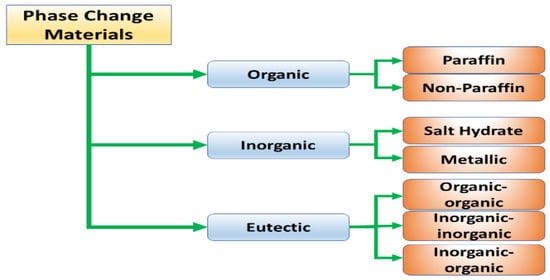
Figure 3.
Types of PCMs.
When considering PCM selection in hot climates, inorganic PCMs, including salts and metal hydrates, are worth examining. Inorganic PCMs exhibit advantages such as higher latent heat capacity (over 220 kJ/kg), higher thermal conductivity (ranging from 1.35 W/m·K to 4.3 W/m·K), higher density (ranging from 1.47 g/cm3 to 2.18 g/cm3), and better fire resistance compared to organic PCMs [42]. However, these materials suffer from undercooling, phase segregation, dehydration, and corrosion, rendering them unsustainable for longer time frames and impairing their viability as latent heat storage systems. [43,44]. The most prevalent salt hydrate PCMs are disodium hydrogen phosphate dodecahydrate, sodium sulfate decahydrate, sodium acetate trihydrate, magnesium sulfate heptahydrate, calcium chloride hexahydrate, and potassium nitrate [45]. However, further research is required in the materials field to enhance their viability for use in energy storage applications.
Eutectic PCMs consist of a combination of organic and/or inorganic compounds that dissolve at a specific atomic ratio, resulting in a crystal mixture through crystallization that can melt and freeze alternately. This property makes them more desirable since they exhibit superior latent heat. The solid structure is characterized by a laminated composition of various compounds, preventing any changes in components and allowing for a non-segregated melting and solidification phase [46]. Despite being a potentially innovative PCM, there are limited studies on the use of eutectic mixtures [47,48,49,50]. As evident, PCM selection can be complicated; therefore, Yang et al. proposed a method for PCM selection established on the basis of multi-criteria decision-making as an attempt to overcome the conflicting characteristics of PCMs, which improved PCM selection to some extent [51].
3. PCM Cooling Application
The cooling load in buildings has significantly increased due to the combined effects of internal heat gains from increased indoor equipment, heat islanding, and an overly glazed urban environment [52,53,54], emphasizing the need for energy storage [55], recently achieved by PCM integration into the built environment [56,57,58,59,60,61]. The building cooling approach relies on three methods—decreasing heat input, minimizing temperature changes, and increasing heat dissipation—to prevent the temperature from exceeding a predetermined threshold [62]. The use of PCMs can effectively achieve all of these objectives by (i) providing free nighttime cooling storage; (ii) providing daytime solar energy storage to drive absorption chillers; (iii) providing air pre-cooling for air conditioning systems to reduce the peak load; and (iv) integrating PCM storage into evaporative cooling systems [63,64].
3.1. Free Cooling
Free cooling exploits the tremendous cooling potential available in the cold nighttime air by mechanically circulating the cold air into a heat storage unit, typically involving PM, to charge or discharge the unit through latent heat absorption and release. In most cases, a daily average temperature swing of 12–15 °C has been observed between day and night ambient temperatures, which perfectly matches the temperature window for absorption and release of heat through PCM by carefully opting for a suitable PCM melting point reportedly between 19–24 °C [65,66].
The fundamental concept of a free cooling system that utilizes PCM can be divided into two distinct modes of operation, as shown in Figure 4: During the night, when the outside temperature is lower than the building interior, the PCM solidifies until thermal equilibrium between the PCM and the outside temperature is established. During the daytime, the warm air flows through the storage unit, where it releases heat to the solid PCM, causing the melting process to begin and cooling the air to be served indoors [67].
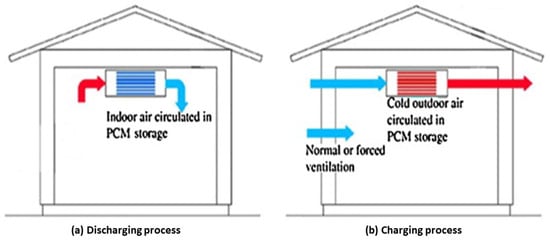
Figure 4.
Concept of free-cooling PCM charging and discharging, reproduced with permission of [67], Elsevier, 2014.
Mosaffa et al. [68] conducted a study that involved numerical analyses of how a TES unit with several PCMs could enhance the efficiency of a free cooling system. The study’s findings indicated that the combination of CaCl26H2O and RT25 in an air channel with a thickness of 3.2 mm, a length of 1.3 m, and a PCM slab thickness of 10 mm resulted in an optimal coefficient of performance (COP) of 7.0 (Figure 5). The authors also conducted a study on a multiple PCM-based free cooling system and found that an optimum COP of 7.63 was achieved for a cooling load of 4.38 kW to meet the comfort conditions for Eindhoven. The optimum air channel thickness, length, and slab thickness to keep the outlet air temperature below 20 °C for 8 h were also identified, along with the maximum flow rate and power consumption [69]. Anisur et al. [70] conducted a study to investigate the use of a shell and tube latent heat storage (LHS) system with heptadecane, which has a melting point of 22.33 °C, for active air cooling. They found that a higher coefficient of performance (COP) could be achieved with a higher inlet air temperature while maintaining a practically equal outlet air temperature. Therefore, the design of an LHS system should consider the appropriate inner radius and thickness of the tube. Darzi et al. [71] found that storing cold air at night and releasing it during the day can achieve free cooling ventilation at night. To identify the optimal layout for plate-type storage filled with PCMs, they conducted a numerical study. The authors observed that the melting process is directly proportional to the thickness of the plate, and increasing the mass flow rate leads to higher cooling power. Rouault et al. [72] explored the use of PCMs in LHTES systems consisting of square-section tubes. They developed a model to simulate thermal transfer and considered the effects of recirculating melted PCMs on heat transfers. The study confirmed the modeling predictions and highlighted the significance of improving heat exchanges between air and tubes to enhance cooling efficiency. The authors suggest that accurate heat transport models must be developed and validated during the PCM solidification process.
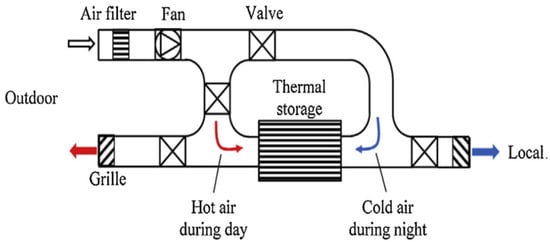
Figure 5.
Installation of thermal storage for free cooling, reproduced with permission of [69], Elsevier, 2013.
The performance of two distinct prototypes of PCM heat exchangers was explored by Lazzaro et al. [73]. Prototype 2, which had a superior design, displayed higher cooling power and shorter melting times than Prototype 1, despite lower stored energy and thermal conductivity. Furthermore, the duration of cooling capacity for PCM heat exchangers for total energy storage was observed to depend on cooling power demand. Tan and Zhao [74] proposed the use of PCM as a heat sink to decrease the hot side temperature in a thermoelectric cooling system designed for space applications. Experimental results revealed a 56% rise in the average cooling COP, and the authors presented a comprehensive design guide. They emphasized the importance of analyzing local weather conditions to ensure complete PCM discharge at night and highlighted cooling power output and COP. Panchabikesan et al. [75] proposed a modified cooling system with spherically encapsulated PCM and water spray nozzles to enhance free cooling potential. The system achieved a significant reduction in charging duration and an increase in heat transfer rate compared to the conventional system. The integration of the evaporative cooling unit helped the PCM solidify faster and improve thermal performance. The system can be used as a standalone cooling system or integrated with HVAC systems to achieve energy efficiency.
Maccarini et al. conducted a simulation study, the results of which are discussed in this paper. The research aimed to provide initial estimates of the primary energy consumption of a new HVAC system across different thermal plant configurations, including district heating and cooling networks, reversible air-to-water heat pumps, and free cooling devices. The findings indicate that [76]. Using a packed bed latent heat storage unit as part of the building’s infrastructure, Nagano et al. [77,78] presented a floor supply air cooling system. Foamed glass beads and paraffin wax, with a melting or solidification temperature of 20 °C, made up the latent heat storage. The system conserved 1.79 MJ/m2 of cooling energy by using air conditioning at night to circulate cold air. The authors argued that the tested office space’s whole daytime cooling need might be met by doubling the quantity of PCM. In Istanbul, Turkey, Bulut and Aktacir [79] investigated the possibility of free cooling for an all-air HVAC system and concluded that energy savings are possible during transition months but not during the summer. In Amman, Jordan, Jaber, and Ajib [80] designed a new PCM-based cooling system for homes. A rectangular, corrugated flat tube with PCM layers and bidirectional airflow passageways made up the heat exchanger. A longer heat exchanger has a bigger cooling load than a wider one, according to the results of parametric research.
Osterman et al. [81] investigated the feasibility of a proposed TES system for cooling and heating indoor spaces by analyzing its annual performance both mathematically and experimentally. They found that higher diurnal temperature changes cause the greatest accumulation of cold in the months of August and July.
Using validated numerical models, M. Alam et al. [82] compared and analyzed the efficacy of PCM for free cooling in a residential building in Melbourne, Australia. The peak interior zone temperature dropped by 2.6 °C throughout the seven-day study period when a PCM with a 25 °C melting point was applied, as presented in Figure 6.
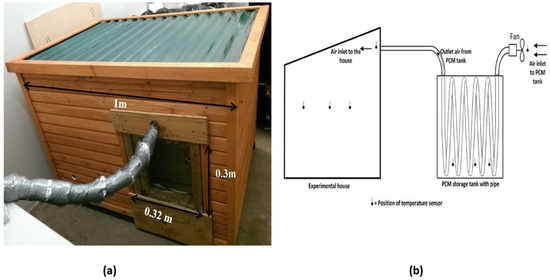
Figure 6.
(a) Experimental Setup and (b) schematic diagram for the evaluation of free cooling, reproduced with permission of [82], Elsevier, 2017.
For low-energy building cooling, J.R. Turnpenny et al. [83] evaluated a latent heat storage unit using heat pipes embedded with PCM, as shown in Figure 7, through a one-dimensional numerical heat transfer model. When the temperature difference between air and PCM was 5 °C, a heat transfer rate of roughly 40 W during melting was maintained for up to 19 h.

Figure 7.
Schematic of proposed heat pipe/PCM installation, reproduced with permission of [84], Elsevier, 2000.
In [84], Jaworski examined a unique design incorporated into a building’s ventilation system composed of a composite material that contains approximately 27% PCM, as shown in Figure 8. The results indicated that during the day, ambient air passing through the channels within the panel is cooled down by 3 °C.
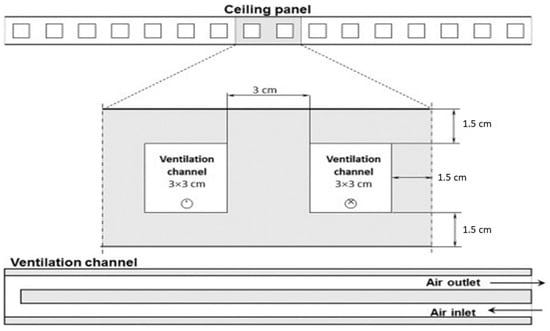
Figure 8.
The scheme of the repetitive elements of a ceiling panel, dimensions of the experimental set-up, reproduced with permission of [84], Elsevier, 2014.
Vincenc Butala and Uros Stritih [85] experimentally measured inlet and outlet air temperatures and airflow for seven days to test the cooling effectiveness of a thermal buffer filled with PCM, as shown in Figure 9. The findings indicated that airflows greater than 1.5 m/s and incoming air temperatures below 30 °C were incompatible with the buffer’s length.
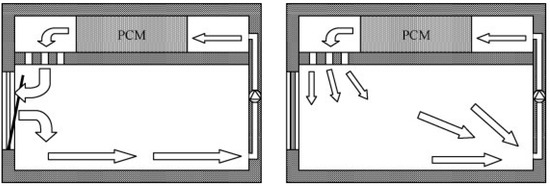
Figure 9.
Experimental of the PCM based cooling system reproduces with permission of [86], Elsevier, 2009.
PCM paint composites offer a viable, free cooling strategy for building cooling applications. Han et al. [86] coated a microencapsulated phase change material (MEPCM) paint composite in a test room. The findings revealed a reduction in temperature ranging from 5 °C to 6 °C, along with a significant 26% reduction in electricity consumption. Jeong et al. [87] studied MEPCM/hydrophilic paint composite and MEPCM/hydrophobic paint composite coated on heat-storage tiles used as a TES system for roofing materials. The results indicated that it exhibited higher latent heat capacity, superior thermal properties, and building compatibility. Lei et al. [88] examined the incorporation of PCM into a cementitious skim coat and a cool-colored coating on the exterior. They observed monthly cooling energy savings ranging from 5% to 12%, demonstrating the potential of this approach for energy efficiency in cooling. Soudian et al. [89] investigated the integration of PCM and thermochromic paint into cementitious plaster as an exterior facade finish material. Their findings showed a 23% increase in solar reflectance, contributing to reduced heat absorption. Additionally, the combination exhibited a higher rate of solar absorption compared to regular cement plaster in cold temperatures. Baskar et al. [90] studied the application of a form-stable PCM/paint composite coated on mortar cubes. They observed a reduction in the surface temperature of the mortar cube by 2.5 °C compared to conventional mortar cubes, indicating the effectiveness of this composite in temperature regulation. Ma et al. [91] investigated the PCM/paint composite coated on the interior walls. The findings revealed a reduction in the surface temperature of the walls by 2.5 °C, enhancing the thermal comfort within the space.
Ali et al. [92] studied PCM/paint composite coated on the exterior of concrete panels. The study indicated a significant decrease in the surface temperature of the walls by 9 °C. Moreover, it was found that the annual energy consumption could be reduced by an impressive 64.3%. Overall, these studies demonstrate the potential of PCM paint composites in building applications, offering advantages such as temperature reduction, energy savings, and improved thermal comfort. Onj et al. [93] studied the integration of MEPCM and glass bubble (GB) into paint and coating on mortar panels shown in Figure 10 in tropical regions. A surface temperature decrease of 3.2 °C indoors and 5–7 °C outdoors was observed.

Figure 10.
(a) Experimental setup for MEPCM and GB Coating study (b) Layout of sensors inside the mortar block, reproduced with permission of [93], Elsevier, 2023.
Yang et al. [94] optimized the geometry of enclosed PCM capsules for passive cooling applications in buildings through a ceiling panel, as shown in Figure 11. The pyramid array panel had the best thermal performance among the evaluated panel designs, reaching a 20.8% greater average melting rate than the tetrahedral-based panel.
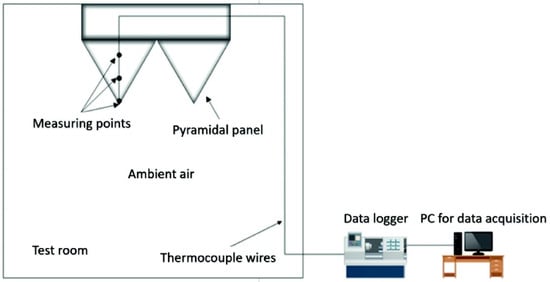
Figure 11.
The schematic diagram for enclosed PCM capsules for passive cooling applications, reproduced with permission of [94], Elsevier, 2023.
Roy et al. [95] studied a novel design of an air-PCM heat exchanger, reporting a maximum temperature difference of 1.4 °C and a cooling effect of 2.05 kWth, reducing the air conditioner capacity by 13% to 46%, depending on ambient temperature. Baskar and Chellapandian [96] conducted a study on a form-stable PCM-based roofing system applied to hollow clay tiles with polymer cement mortar and expanded perlite for stability, as shown in Figure 12. They reported an interior temperature drop of 8–10 °C.
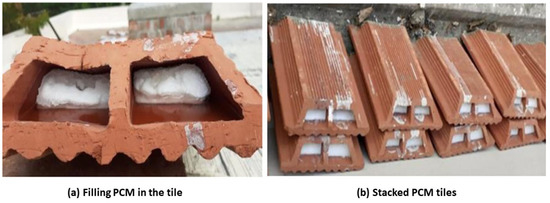
Figure 12.
Experimental setup.
Gallardo and Berardi [97] proposed a novel cooling system that utilizes macro-encapsulated PCM discreetly integrated beneath standard radiant ceiling panels (RCP) as an alternative to traditional all-air systems in office buildings for peak shifting, as shown in Figure 13. The results revealed that the RCP-PCM system passively absorbed heat gains ranging from 180 to 230 Wh/m2 during the daytime and actively operated solely at night during unoccupied periods. The measured passive cooling power varied between 11 W/m2 and 31.4 W/m2, with an average of approximately 17.3 W/m2.

Figure 13.
Pipe network connecting all the RCP-PCM panels.
Zhao et al. [98] conducted a study to evaluate the performance of a novel MEPCM using suspension polymerization, as shown in Figure 14. The experimental results revealed that the board containing 30 wt.% MEPCM showed a significant 67.82% improvement in TES compared to the conventional construction material within the temperature range of 10–50 °C.

Figure 14.
Thermal regulation test with CB@microPCM320 board as an example.
Singh et al. [99] studied the integration of eutectic PCM into concrete, highlighting its favorable impact on thermal, physical, and mechanical properties when blended with zeolite to form a shape-stabilized composite as shown in Figure 15. Among the different compositions, SSCPCM-39% exhibited superior performance in regulating indoor temperature, achieving a remarkable reduction of 14.51% in peak temperature and a significant time delay of 71 min.
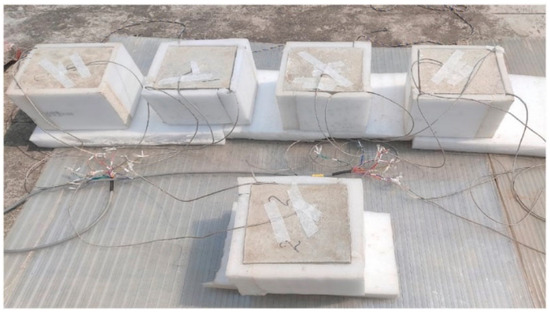
Figure 15.
Experimental setup to evaluate the indoor thermal performance of TES-C0, TES-C1, TES-C2, TES-C3, and TES-C4.
In [100], Durakovic studied suitable methods for passive heating and cooling involving heat dissipation, modulation, and protection, utilizing building thermal mass and environmental heat sinks. The study primarily focuses on PCM-based passive solar concepts. In conclusion, free cooling with PCM proves to be more effective in reducing peak indoor zone temperatures compared to passive cooling.
3.2. Solar Cooling Systems with PCM
A solar cooling system is an air conditioning system that primarily uses solar energy to power its operation. It consists of solar collectors to absorb solar energy, an absorption or adsorption cooling process to transfer the heat, a refrigeration cycle to cool the air, and a cooling distribution system to circulate the cooled air [101]. Recent research has focused on PCM solar cooling systems, which utilize adsorption and absorption cooling and present an alternative to conventional air conditioning systems. To replace conventional wet cooling towers, a solar-powered absorption cooling system combined with PCM and a dry air cooler has been proposed and illustrated in Figure 16 [102].
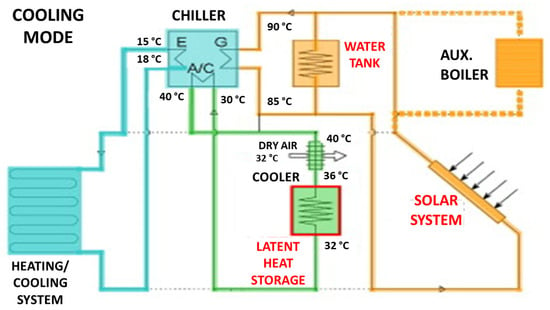
Figure 16.
Solar heating and cooling system with absorption chiller, reproduced with permission of [102], Elsevier, 2009.
PCM-based solar cooling systems exhibit improved performance and durability during the night. To enhance the efficacy of solar cooling systems, various technologies such as absorption and adsorption systems, air coolers [103], heat exchangers [104], rooftop systems, and TES with PCM have been integrated [105,106].
Zheng et al. [107] studied the efficiency of a solar cooling system with an integrated micro PCM and found that it might reduce cooling costs by 30.5%. Harikrishnan et al. developed a composite PCM for solar heating systems, combining paraffin with hybrid nanomaterials (CuO-TiO2). The incorporation of hybrid nanomaterials resulted in improved thermal performance, with a significant reduction of 29.8% in melting time and 27.7% in freezing time observed for the composite PCM containing 1.0 mass% of hybrid nanomaterials, when compared to pure paraffin [108]. Stritih et al. investigate the application of latent heat thermal energy storage (LHTES) heated by a solar energy collector installed on the facade of an office building. The aim is to minimize energy usage for heating ventilation air. They develop a numerical model of the LHTES unit, which is then utilized to calculate the annual savings achieved by implementing this system. This research highlights the potential of LHTES combined with solar energy for improving energy efficiency in buildings [109]. Belmonte et al.’s [110] reported that the use of PCM in the chiller’s heat rejection loop increased the effectiveness of the absorption-type solar cooler by up to 38%. Stropnik et al. [105] and Chinnasamy and Appukuttan [106] have also conducted a reported decrease in the cooling load by the integration of PCM into the cooling system. Henning reviewed the studies on the solar-assisted air conditioning of buildings [111].
Helm et al. [112] coupled a solar-powered absorption cooling system with PCM and a dry air cooler. Based on their findings, they hypothesized that by integrating PCM into the heat rejection circuit of the chiller, some of the needed power might be moved to off-peak hours. Gil et al. [111,112,113,114,115] developed a TES system for solar cooling applications at the University of Lleida that was subsequently implemented in an actual installation for cooling purposes on the roof of a building in Seville, as shown in Figure 17 and Figure 18. Figure 19 shows the use of PCM in the chiller’s heat rejection.
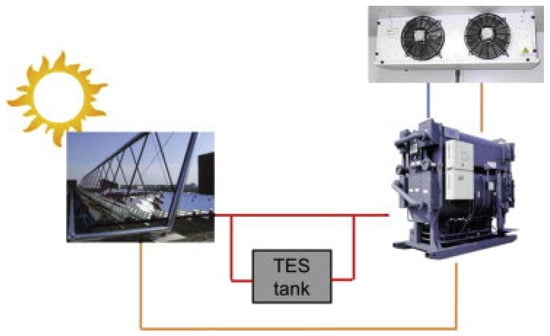
Figure 17.
The placement of the storage tank for PCM in the context of solar cooling, reproduced with permission of [115], Elsevier, 2014.
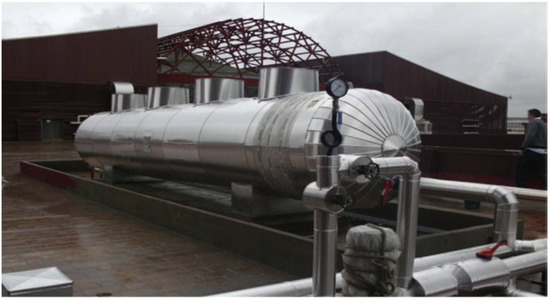
Figure 18.
The University of Sevilla (Spain) has installed a storage tank in an actual solar cooling system, reproduced with permission of [115], Elsevier, 2014.
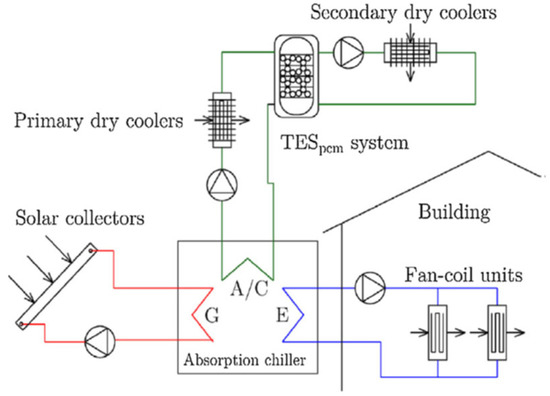
Figure 19.
A solar cooling system comprising of TES PCM and dry coolers, reproduced with permission of [110], Elsevier, 2014.
It was concluded that dead PCM volumes can be avoided in a practical PCM storage tank design with the help of finned storage systems.
Besides, it was reported that the traditional system is more reliable in terms of the chiller’s COP and cooling energy generated at all locations. Agyenim et al. [116] designed a tube heat exchanger utilizing PCM to augment the COP of the LiBr/H2O absorption cooling system and determined an optimal amount of PCM to boost the COP of the solar cooling system.
In conclusion, solar cooling systems with PCM have the potential to reduce power consumption and pollution while providing comfortable summer conditions in buildings, although they may have some reliability issues that need further research and optimization.
3.3. Air Conditioning System with PCM
Several researchers have proposed air conditioning systems that utilize PCM thermal storage. Fang et al. [117] introduced a model that employs a cooling system utilizing a spherically packed bed for storing cold air. The addition of the spherical-packed bed structure enhanced the system’s performance and stability during both charging and discharging cycles. Allouche et al. [118] conducted performance evaluations of solar-powered air conditioners with PCM-integrated cold storage using TRANSYS software. The results indicated a rapid decrease in the temperature within space. Chaiyat [119] conducted an energy and economic study of a PCM-integrated air conditioning system, as shown in Figure 20. The observed outcomes were a 9% reduction in power usage and a payback time of over 4 years.
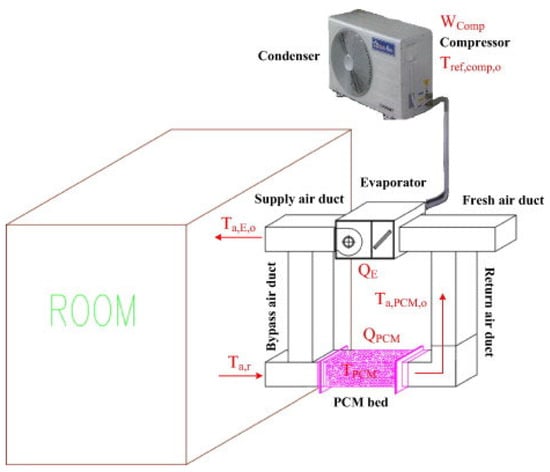
Figure 20.
A schematic diagram illustrating an air conditioning system incorporating PCM, reproduced with permission of [119], Elsevier, 2015.
Using a shell and tube—PCM heat storage unit, Zhao and Tan [120] improved the COP of a conventional air conditioner by using water as the HTF in the charging loop and air as the HTF in the discharge loop. Several variables, such as HTF mass flow rate, input temperature, and fin height, were tested in order to determine their effects.
Haggag et al. [121] studied the performance of PCM-based air pre-cooling in the hot climate of the UAE. The results reported a temperature drop of up to 11 °C, indicating the efficacy of such systems in the UAE climate.
3.4. Enhanced Evaporative and Radiative Cooling with PCM
Evaporative systems, radiative systems, and hybrid systems are all feasible choices for passive cooling in buildings. Utilizing PCMs, microchannel heat pipes, and radiative cooling, Shen et al. [122] and El Loubani et al. [123] evaluated passive cooling of the building wall utilizing a radiatively cooled PCM (RC-PCM), as illustrated in Figure 21. Incorporating PCM into an evaporative cooling system reduced the cooling load by 25% compared to a conventional wall.
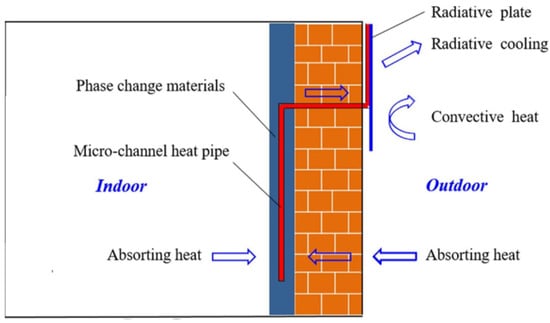
Figure 21.
Schematic of RC-PCM wall, reproduced with permission of [122], Elsevier, 2020.
Micro-heat pipes, radiative cooling, and PCM were all incorporated into a single wall by Yu et al. [124,125]. When a micro-heat pipe is installed in the wall, the PCM solidifies much more quickly. When compared to a standard brick wall, an annual energy savings of 18.2% was reported. Wang et al. [126] evaluated a combination of cooled ceiling, micro-PCM slurry, and radiative cooling in five climatic regions in China, reporting increased energy efficiency.
Durakovic and Torlak [127] investigated the application of PCMs in a temperature-responsive window system using a combination of experimental and numerical approaches to optimize the cavity thickness. The results indicate that the recommended cavity thickness ranges from 24 mm when exposed to radiation to 19 mm in the absence of radiation.
4. Heat Transfer Improvements
One of the most important challenges to effectively utilizing PCMs for cooling and heating remains the heat transfer rates, which significantly impact the efficacy of these systems. Lower heat transfer rates significantly delay the melting and solidification of the PCMs, which is mainly attributed to lower PCM thermal conductivity [128,129,130]. Several interventions have been investigated to enhance heat transfer, including conductive nanoparticles, extended heat transfer surfaces, porous materials, and high-conductive fiber materials [131,132,133,134,135], as summarized in Figure 22.
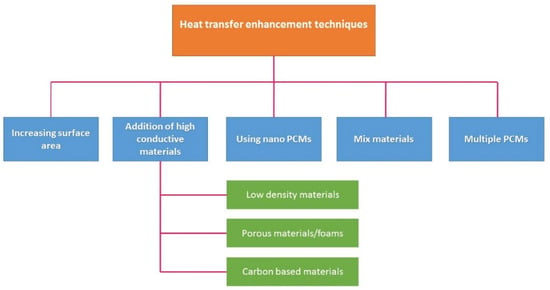
Figure 22.
Methods of heat transfer improvement.
4.1. Surface Area
To decrease the melting/solidification time, researchers are analyzing the performance of the geometry of cavities or devices filled with PCM. An increase in the thermally contributing surface area can be achieved by deploying fins or expanded surfaces [136,137,138,139,140,141,142], resulting in up to a two-fold increase in the heat transfer rates [143]. A comparison between oblate elliptical capsules and spherical capsules containing PCM was conducted using COMSOL, and it was discovered that the oblate elliptical capsule melted in less time [144], attributed to a larger surface area. The experimental investigation also indicated that employing polyethylene elliptical capsules with 1-octadecanol PCM resulted in a 50% reduction in charging duration and a 35% reduction in discharging duration compared to the spherical capsules depicted in Figure 23.
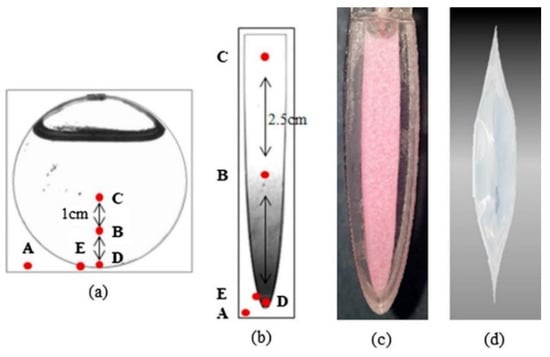
Figure 23.
Schematic view of spherical and elliptical capsules, (a) location of thermocouples in spherical capsule and (b) elliptical capsule, (c) test mock-up of elliptical capsule for PIV-LIF, (d) photo of PCM in an elliptical capsule.
In [145], melting and heat transfer in vertical and horizontal TES units containing PCM have been studied for different values of the mushy zone parameter. Numerically, it has been demonstrated that the melting time of lauric acid PCM is lower for horizontal enclosures compared to vertical enclosures. A schematic diagram of the two-dimensional simulation geometry is shown in Figure 24.
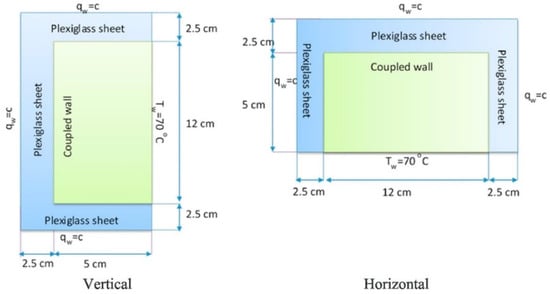
Figure 24.
Schematic diagram of horizontal and vertical TES.
A new triangular fin design has been suggested to improve the solidification effectiveness of shell and tube LHTES devices. Two novel fin configurations (Fin-B and Fin-C) were compared to the traditional rectangular fin (Fin-A) typically used in LHTES devices. The solidification duration of Fin-C was found to be considerably reduced by 38.30% when compared to conventional Fin-A. These findings indicate that using the longitudinal triangular fins can significantly improve the solidification performance of PCM in LHTES. Furthermore, the temperature response of the high-performing fins was analyzed to understand their dynamic behavior, as shown in Figure 25 [146].

Figure 25.
Traditional and innovative longitudinal triangular fin configurations.
In order to enhance the heat transfer rate of a shell-and-tube energy storage device, topology-optimized fins shown in Figure 26 were compared both numerically and experimentally with standard squared fins. It was concluded that the topology-optimized device outperformed the standard square fins with a 57.1% shorter discharge time [147].
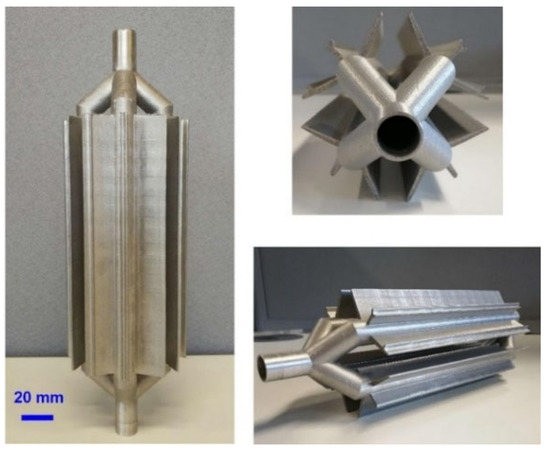
Figure 26.
The additive manufactured topology optimized device.
Numerical investigations were conducted on a vertically finned LHTES unit, considering design factors such as fin height and pitch. Four different fin configurations were analyzed, concluding that radial-finned LHTES units reduced the entire melting time by 44.0% compared to LHTES units without fins with an optimal fin height of 0.642. The thermal performance of vertically finned LHTES was also tested for lower, upper, middle, and arithmetic fin configurations. The findings suggest that using arithmetic fins may reduce the total melting time by 49.9% [148] (Figure 27).
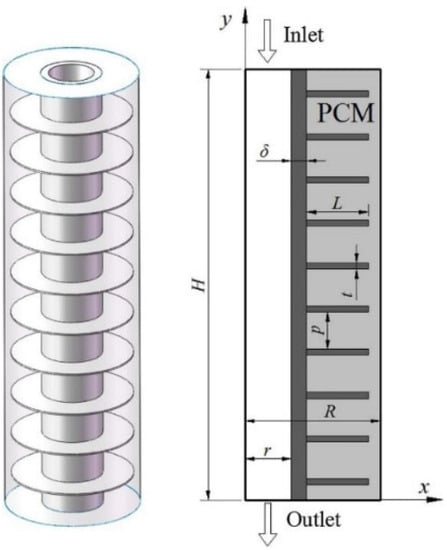
Figure 27.
Schematic diagram of the radial-finned shell-and-tube LHTES unit and computation domain, reproduced with permission of [148], Elsevier, 2020.
Another study [149] compared six different fin designs with a baseline design having no fins as shown in Figure 28 and reported a significant decrease in the overall PCM discharge time in all cases using fins compared to the baseline design.
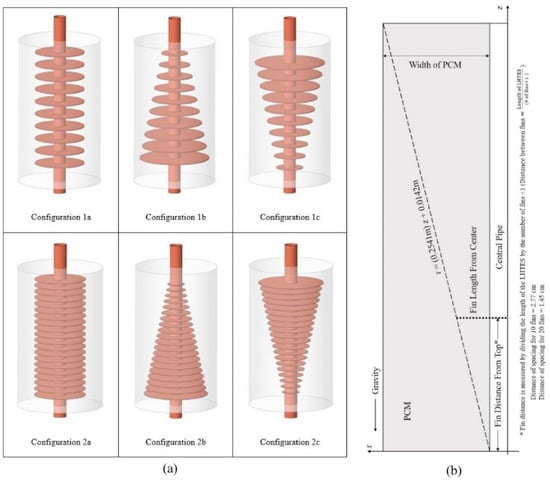
Figure 28.
(a) Physical models of the six configurations that include fins, 1 represents 10 fins, 2 represents 20 fins, and configuration style is denoted by a, b, and c. (b) Two-dimensional mathematical schematic used for determining the variable fin lengths, reproduced with permission of [150], Elsevier, 2021.
Taghavi et al. [150] (Figure 29) proposed a modified plate-type thermal energy storage system (PTES) to address the challenge of rapid temperature fluctuations during the charging and discharging processes. They reported a significant drop in temperature variation with a 75% increase in energy storage capacity per unit volume.

Figure 29.
Schematic diagram of the experiment [150].
Aly et al. utilized corrugated longitudinal fins to accelerate the solidification rate of formic acid PCM in an LHTES system, resulting in a 30–35% decrease in solidification time compared to flat fins [151]. Prithvi Raj R. et al. [152] discovered that the melting time of a cylindrical fin’s PCM zone is directly proportional to its diameter but not influenced by the height of the PCM zone. Water solidification in a heat exchanger with branch-shaped fins was investigated by Asgari et al. [153], who reported that thinner fins shaped like branches had a stronger impact on the rate of solidification.
4.2. Thermal Conductivity Enhancement
TES systems’ capacity utilization is restricted by their low heat conductivity, which has been extensively studied to overcome the issues reported in the following sections.
4.2.1. Expanded Graphite Insertion
To enhance the thermal conductivity of a PCM-based energy storage unit, a composite consisting of graphite foam and eutectic salt was evaluated. It was reported that thermal conductivity increased by 102% compared to pure eutectic salt owing to the high thermal conductivity of graphite [154]. Encapsulation made of expanded graphite was also utilized for a night sky radiator, which provided self-activated heat removal and thermal management for a battery [155].To enhance the thermal conductivity of a PCM-based energy storage unit, a composite consisting of graphite foam and eutectic salt was evaluated. It was reported that thermal conductivity increased by 102% compared to pure eutectic salt owing to the high thermal conductivity of graphite [154]. Encapsulation made of expanded graphite was also utilized for a night sky radiator, which provided self-activated heat removal and thermal management for a battery [155].
To produce a nanocomposite consisting of a PCM and metal oxide, magnesium nitrate hexahydrate was combined with nanoparticles of titanium dioxide (TiO2), zinc oxide (ZnO), ferric oxide (Fe2O3), and silicon dioxide (SiO2). It was discovered that by using 0.5 wt.% TiO2, the charging and discharging rates increased by 33% and 77.5%, respectively, compared to using pure PCM [156]. Zou et al. [157] proposed employing expanded graphite/alkanes for drilling in hydrate reservoirs, which enables the removal of heat generated during drilling. Meanwhile, he utilized shape-stabilized expanded graphite to store cold energy and found that adding a small amount of expanded graphite can improve thermal conductivity without causing PCM leakage. It is evident that incorporating expanded graphite can significantly improve the thermal conductivity of PCM, which could be beneficial for numerous applications, particularly in designing a TES system to lower a building’s cooling demand. Nonetheless, the LHTES capacity and phase transition temperatures are not significantly impacted.
4.2.2. Copper Foaming
Copper foams are an ideal choice for applications that require efficient thermal conductivity due to their high surface area-to-volume ratio, which is attributed to their porous structure. The thermal performance of PCM in comparison with copper foam was evaluated at eight varying filling ratios using numerical modeling. The findings showed that incorporating copper foam in PCM resulted in a reduction in melting and solidification times driven by an enhanced rate of heat flow, temperature response, and heat flux [158]. The form-stabilized composite PCM, which is suitable for energy storage and conversion, was developed [159]. The study used graphene aerogel, copper foam, and PCMs with four different melting temperatures, revealing that the thermal conductivity was enhanced by a factor of 9 when compared to paraffin PCM. A composite material with high stiffness and toughness and electro-to-thermal conversion properties was developed by [160] for thermal energy control and exhibited superior thermophysical properties. In a study investigating the impact of copper foam on the thermal behavior of PCM at different inclination angles in solar applications, it was determined that a 180° angle provided optimal thermal charging and discharging. The study evaluated twelve inclination angles of a thermal storage unit using two temperature equations [161]. The impact of incorporating copper foam on the performance of phase-change materials was explored by Gao et al. [162]. They discovered that by changing the shape and distribution of the copper foam, they could increase the average heat flow by 336.83 W/m2 and the temperature response rate by 0.00459 °C/s, thereby reducing the melting time by up to 4143 s. The foam shape developed in Model-4 demonstrated maximum thermal performance among the six possible models. In order to increase heat transmission efficiency, Pu et al. examined copper dispersion with multiple PCMs. They discovered that a single PCM outperformed a radial multiple PCM, cutting the total melting time by up to 87.50%. The TES is significantly impacted by the copper foam’s porosity [163].
4.2.3. Aluminum Foams
Aluminum foam is often utilized in combination with PCMs to enhance the heat conduction rate between components. However, its application is restricted to salts with high melting points, such as NaCl, KCl, KNO3, NaNO3, and MgCl2. Zhang et al. incorporated PCM into aluminum foam and found that non-dimensional factors, including the Reynolds number, Rayleigh number, and porosity, affect the heat transfer properties of composites [164]. The aluminum-foamed TES system significantly enhanced heat transfer by facilitating the primary conduction mechanism that takes place during the melting of PCM, leading to a much faster phase change process compared to pure PCM [165]. Caliano et al. conducted a numerical study to investigate the potential of PCM composite with aluminum dispersion in refrigerated environments. They reported that the charging cooling energy was largely affected by the conductive heat transfer, particularly by the solid PCM layer that forms on the side wall of the aluminum container. Natural convection heat transfer, on the other hand, had the greatest effect on cooling energy discharge but was four times less efficient than the traditional system that did not use PCM [166].
4.2.4. Nickel Foams
The high melting point of 1455 °C and the reasonable thermal conductivity of 89 W/mK of nickel foam make it a popular choice for applications requiring rapid heat transfer. The thermal characteristics of a nickel foam-based PCM for battery temperature management were studied by Moussa et al. [167]. According to the findings, the thermal conductivity of PCM increased with nickel foam, while the pore size had little influence. Another study by Hussian et al. [168] investigated the effects of graphene-coated nickel foam dispersed in PCM on thermal conductivity for battery TES. Compared to pure nickel PCM, the thermal conductivity of the graphene-coated nickel PCM composite was 23 times greater, and the battery cooling temperature was enhanced by 17%, according to the research.
Wang et al. investigated nickel foam dispersed with cetyl palmitate composite to improve TES applications. According to the findings, the thermal conductivity of PCM dispersed with nickel foam increased by 1.88, 2.02, and 4.86 times, respectively, compared to pure PCM for 70 PPI, 90 PPI, 110 PPI, and 40 PPI, with a significant increase in durability [169]. A nickel foam-based myristic alcohol composite was used to increase heat conductivity for solar TES applications. A heat conductivity value of 1.80–7.8 times that of pure PCM was observed, attributed to smaller pores [170].
4.2.5. Carbon Foams
Alshaer et al. evaluated paraffin/carbon foam composite (CF/RT65), multi-walled carbon nanotubes (MWCNTs)/CF/RT-65, and pure paraffin (RT-65) modules at 18, 24, and 30 W [171]. Composites of CF and paraffin or MWCNTs and paraffin showed greater heat transfer rates than CF and RT-65, with an increase in thermal conductivity (15%) and latent heat (8.5%). In another study, it was found that the highest overall temperature reduction was achieved with a carbon foam with 60% porosity, with a reduction of the temperature by 2.2 times [172].
A PCM composite [173] built on carbon foam and housed in a stainless-steel tube was created to increase PCM’s efficiency. According to the results of the investigation, the melting time of PCM (RT-35HC) is four times lower than that of pure PCM. The effect of carbon brushes on the thermal conductivity of polycrystalline silicon was also investigated using an experimentally verified computational model [174]. The results demonstrated that the composite’s heat transfer rate improved by increasing both the volume percentage and the diameter of the brush up to a critical diameter.
4.2.6. Graphite Foams
The thermal conductivity of PCM for TES was enhanced by dispersing it in graphite foams [175]. Graphite foam with a porosity of 70% was distributed in a specially formulated molten chloride solution for use in TES subjected to various temperatures. The graphite foam enhanced thermal conductivity by 101 W/mK at 23 °C, 78.2 W/mK at 150 °C, and 62.9 W/mK at 300 °C [176,177]. To increase the composite material’s efficiency in transferring heat, graphite was mixed in paraffin PCM in the form of fibers, fins, and foam, which exhibited increased heat transfer rates [178].
4.3. Nano PCM
In order to enhance the heat transfer rates of TES, one approach is to use nanoPCMs with different types of nanoparticles. Even a small amount of nanoparticles added to the PCM can result in a significant increase in thermal conductivity [179], although it has certain limitations in terms of strength and corrosion resistance owing to the extremely small particle sizes [180].
Arici et al. [181] numerically investigated the melting process inside a square enclosure, where two opposing walls are kept at different constant temperatures and the remaining walls are insulated. The inclusion of a fin in the enclosure leads to a decrease in melting time ranging from 27–52% based on the fin length and 13–68% based on its position. The effect of Ag nanoparticles on the thermal conductivity of composite materials composed of organic PCM and Ag nanoparticles was investigated by Zeng et al. [182]. The results showed that an increase in the number of Ag nanoparticles enhanced the thermal conductivity of the composite materials. However, the phase change temperature range decreased compared to pure PCM.
The performance of pure PCM and nanoparticle-enhanced PCM was investigated by Nitsas et al. [183]. It was observed that the duration of melting decreased by at least 10%; however, it resulted in a reduction of 11.5% in the heat storage capacity of PCM as well. The utilization of MnO2 nanowires and nanotubes as nanofillers to enhance the thermal conductivity of organic PCMs was investigated by Liang et al. [184]. The findings indicated a 3.7-fold increase in the thermal conductivity of the nanocomposite compared with pure PCM, with a thermal cycling stability of at least 100 cycles.
5. Thermal Energy Storage (TES) Integration into Built Environment
The cost-effective and efficient integration of the TES system into the building can significantly enhance its thermal mass, rendering it more resilient against harsh climates [185,186]. Due to urban development and population growth, high-rise building construction has relied on lightweight materials with low thermal masses, reducing the buildings’ heat resistance. Integration of TES into the building skin can overcome the loss of thermal mass caused by lightweight construction with a significantly lower structural load on the building [187].
Within the past ten years, analytical research on the structure of PCMs has been carried out in Europe [188,189,190]. Types of TES have been presented in Figure 30.
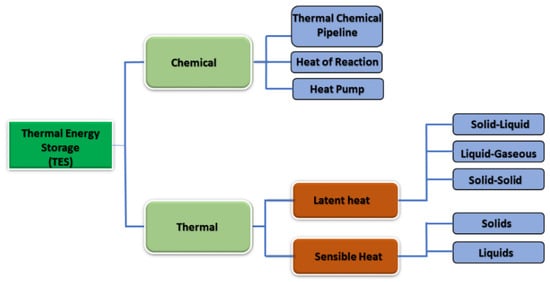
Figure 30.
Types of thermal energy storage (TES).
TES systems can serve both short-term and long-term goals. First, the concept of seasonal heat storage using aquifers to store cold water underground for industrial cooling applications originated in China [191], and the first heating use of aquifers was created in Scarborough Center, Canada [192], with significantly lower heat storage compared to PCMs [193]. Mouridet et al. [194] conducted a study in Casablanca, Morocco, to measure the thermal behavior of two prototypes. They measured various temperatures, including indoor, wall surface, ceiling surface, and outdoor ambient temperatures. The study found that PCM wallboards were more efficient than regular wallboards and resulted in an average energy consumption reduction of 20%. In their study, Li et al. [195] created insulated test rooms with and without PCM integration on the exterior of the north wall to investigate the thermal performance of building envelopes. The results showed that PCM improved the indoor thermal environment and decreased the duration of heating. Karim et al. [196] performed research that looked at the impact of poor insulation and antiquated heating systems on the energy consumption of many European buildings. Using a monitoring system to measure energy flows, they discovered a performance difference in the energy efficiency of up to 287% attributable to user behavior, poor installation, and faulty engineering. Kant et al. [197] studied the thermal performance of a brick embedded with PCM and compared it to three other PCMs: raw paraffin wax, RT25, and capric acid. The results indicated that capric acid was the most effective, resulting in a reduction of up to 8.31% in heat flux. Leanget al. [198] studied a composite solar wall with microencapsulated PCM numerically and reported a greater heat recovery capacity and shorter phase time delay compared to the reference wall.
Mehdi et al. [199] developed a TES system for managing indoor heating in buildings. Utilizing a composite material consisting of paraffin (PA), polyethylene glycol (PEG), and carbon foams (CF), the composites displayed excellent thermal and chemical stability, making them well-suited as heaters for energy management and peak load shifting in buildings. Kunyang et al. [200] introduced a novel PCM named decanoic acid/polyethylene glycol binary eutectic (DA-PEG) for TES. Overall, the findings suggest that the DA-PEG eutectic PCM is a highly promising solution for improving thermal comfort and energy efficiency in buildings.
Osman et al. [201] conducted research on a novel technique for TES by incorporating MEPCM into a gypsum composite that allows light transmission. The addition of 5 wt.% MEPCM slightly reduced compressive and flexural strengths while allowing a 10% light transmittance. Sarcinella et al. [202] designed a TES system based on PCM-modified mortars applied in buildings using Poly-Ethylene Glycol (PEGs) included in flakes of a porous stone, i.e., Lecce Stone (LS), to form-stabilize the composite. The composite reduced cooling and heating loads by 8% and 13%, respectively.
Manglesh et al. [203] created a TES system by integrating PCMs into clay bricks through microencapsulation. The findings revealed a temperature drop of 1.81% to 9.87%, depending on the ratio of PCM used in the brick. Taghreed et al. [204] utilized recycled Tetra Pak waste to create innovative PCMs for TES. The researchers discovered that Tetra Pak materials effectively prevented paraffin leakage in compact form. Zhaoli et al. [205] reported that incorporating PCM into buildings creates a thermal barrier, resulting in summer overheating. To address this issue, they introduced a dynamic insulation system (DIS) that utilizes air flow to enable switchable thermal resistance in the PCM.
Alawadhi [206] evaluated the integration of PCM-based bricks in hot climates and reported a cooling load reduction of 17.55%. Hasan et al. [207] conducted a study in the United Arab Emirates (UAE) to investigate the cooling effectiveness of a PCM incorporated within an insulated concrete block. An 8.5% temperature drop and a 2.6-h time delay in peak indoor temperature were reported, resulting in a 44% reduction in heat gain. It was noted that the high ambient temperature and low wind speed made heat dissipation at night and re-solidification of the PCM difficult through natural ventilation. Therefore, the findings suggest implementing mechanical ventilation systems in hot climates to enhance the regeneration of the PCM to its solid state, ensuring optimal performance. Elnajjar [208] conducted a study exploring the energy-saving potential of integrating PCM into building materials in the UAE for seven consecutive days and reported an average 30% reduction in heat flux over the seven days. Thiele et al. [209] conducted a study investigating the thermal performance of concrete composite walls containing MEPCM throughout the day. The inclusion of PCM in the concrete resulted in a decrease in overall heat transfer across the composite wall.
Ghazal et al. [210] investigated the integration of PCMs in a lightweight building wall in the UAE climate. The findings emphasize the reduction of cooling load through PCM integration, achieved by peak shifting. Piselli et al. [211] conducted a study involving numerical and experimental analysis of a novel cool polyurethane-based membrane integrated with PCMs for roofing applications in Rome, Italy, and Abu Dhabi, UAE. The findings indicate that combining the cool membrane with PCMs within appropriate melting temperature ranges can lead to significant reductions in roof surface temperatures. Kumar’s [212] combined PCM with a double-skin aluminum radiation reflector (ARR) and tested it in the climatic conditions of the Sultanate of Oman. In comparison to a typical bare concrete roof, they reported a temperature decrease of 3.63 °C (9.08%) for room air, 12.68 °C (30.1%) for the internal roof surface, and 16.92 °C (37.3%) for the outdoor roof surface, with a drop of 18 W/m2 heat gain indoors. It is noted through the research findings that the diurnal temperature swing in the Middle East in general and the UAE in specific offers a significant advantage to using PCM, which can help PCM melt during hot days and get back to solid by natural ventilation during cooler clear sky nights.
6. Conclusions
This article provides a literature review of recent research on the use of PCMs as latent heat TES strategies in residential and commercial buildings. The review begins by discussing the concepts of PCMs, their classification, selection criteria, and tests of their properties. The current literature review explores how enhancing the heat transfer area of LHTES devices is not the only approach for energy storage. Composite materials that include expanded graphite, nanoparticles, foam, and microencapsulation can also enhance the thermal performance of PCM. Incorporating these materials raises the heat transfer area between the high-temperature source and PCM, resulting in faster heat conduction. However, adding nanoparticles or foam can reduce the latent heat storage capacity, whereas microencapsulation can prevent PCM leakage and extend its lifespan. Expanded graphite, nanoparticles, and foam are effective in achieving faster heat removal and discharging processes. Nonetheless, the discharging process, which is conduction-dominated, can be hampered by lower thermal conductivity. The charging process, which is convection-dominated, can overcome the limitation of low thermal conductivity. Hence, improving the thermal conductivity of LHTES is crucial to enhancing the speed of the discharging process. The combination of multiple materials, such as nanoparticles, foams, and fins, has been shown to enhance heat transfer and improve the performance of PCMs more effectively than using only one material. Optimizing systems for energy storage will likely be recommended to achieve the best results. This optimization could also make renewable energy more useful in various technology sectors.
The incorporation of TES systems, particularly PCMs, improves building thermal performance and reduces energy consumption. PCM wallboards and exterior PCM integration enhance the indoor thermal environment and decrease heating duration, while also decreasing cooling load through free cooling and maintaining comfortable outlet air temperatures. To create sustainable and energy-efficient buildings, optimizing TES design and developing accurate heat transport models are crucial. Future research should explore TES effectiveness by incorporating various heat transfer augmentation methods in different building types and climates and focusing on enhancing passive and active cooling efficiency. The UAE’s diurnal temperature swing with a significant drop in night temperature under clear sky conditions provides favorable conditions for using PCMs in cooling systems, making it an ideal climate for their implementation.
Author Contributions
This review article is related to a funded research project entitled “Air Pre-Cooling through Phase Change Material Integrated into Chiller Water Cooling System to Reduce Peak Air-Conditioning Demand: Case Study of UAEU”. This project is run by M.H. (PI), A.H. (Co-PI) and U.M. (PhD candidate). The original draft preparation, U.M.; writing—review and editing, all authors; final revision, A.H. and M.H. All authors have read and agreed to the published version of the manuscript.
Funding
This review article is related to a research project funded by the UAE University (Grant number: 12N091). The authors would like to express their appreciation to the Research Office at the UAE University for funding this research project.
Data Availability Statement
Mahmoud Haggag: https://eng.uaeu.ac.ae/en/departments/arch/profile.shtml?email=mhaggag@uaeu.ac.ae. https://scholar.google.co.uk/citations?user=nkn6NfcAAAAJ&hl=en. Ahmed Hassan: http://www.eng.uaeu.ac.ae/en/profile/profile.shtml?banner=700018802. Mohammed Laghari: http://www.eng.uaeu.ac.ae/en/docs/laghari_resume.pdf. Usman Masood: https://scholar.google.com/citations?user=o1ellPkAAAAJ&hl=en&oi=ao.
Conflicts of Interest
The authors declare no conflict of interest.
References
- United Nations Framework Convention on Climate Change. The Paris Agreement. 2015. Available online: https://unfccc.int/process-and-meetings/the-paris-agreement/the-paris-agreement (accessed on 27 January 2019).
- Intergovernmental Panel on Climate Change. Global Warming of 1.5 _C. 2018. Available online: https://www.ipcc.ch/sr15/ (accessed on 27 January 2019).
- IEA. Energy Technology Perspectives: Towards Sustainable Urban Energy Systems; IEA: Paris, France, 2016; Volume 14. [Google Scholar]
- Dominkovi’c, D.F. Modelling Energy Supply of Future Smart Cities; Technical University of Denmark: Kongens, Denmark; Lyngby, Denmark, 2018. [Google Scholar]
- Hooftman, N.; Oliveira, L.; Messagie, M.; Coosemans, T.; Van Mierlo, J. Environmental Analysis of Petrol, Diesel and Electric Passenger Cars in a Belgian Urban Setting. Energies 2016, 9, 84. [Google Scholar] [CrossRef]
- IEA. Energy and Air Pollution; IEA: Paris, France, 2016. [Google Scholar]
- Li, D.; Wang, Q.; Lin, P.; Chen, Y. Analysis of the Heat-Flux Characteristics of the Turbulent Boundary Layer in the Trombe Wall. J. Energy Eng. 2021, 147, 04021052. [Google Scholar] [CrossRef]
- Narbuts, J.; Vanaga, R.; Freimanis, R.; Blumberga, A. Laboratory Testing of Small-Scale Active Solar Façade Module. Environ. Clim. Technol. 2021, 25, 455–466. [Google Scholar] [CrossRef]
- Patel, J.H.; Qureshi, M.; Darji, P. Experimental analysis of thermal energy storage by phase change material system for cooling and heating applications. Mater. Today Proc. 2018, 5, 1490–1500. [Google Scholar] [CrossRef]
- Choblet, F.; Gicquel, P.; Schmitz, A.P.; Fang, Y. Le Changement Climatique: Gouvernance Politique et Économique. Climatiques 2007, 80. [Google Scholar]
- Isaac, M.; van Vuuren, D.P. Modeling global residential sector energy demand for heating and air conditioning in the context of climate change. Energy Policy 2009, 37, 507–521. [Google Scholar] [CrossRef]
- Souayfane, F.; Fardoun, F.; Biwole, P.H. Phase change materials (PCM) for cooling applications in buildings: A review. Energy Build. 2016, 129, 396–431. [Google Scholar] [CrossRef]
- Connolly, D.; Lund, H.; Mathiesen, B. Smart Energy Europe: The technical and economic impact of one potential 100% renewable energy scenario for the European Union. Renew. Sustain. Energy Rev. 2016, 60, 1634–1653. [Google Scholar] [CrossRef]
- Kuznik, F.; Virgone, J.; Noel, J. Optimization of a phase change material wallboard for building use. Appl. Therm. Eng. 2008, 28, 1291–1298. [Google Scholar] [CrossRef]
- Kalnæs, S.E.; Jelle, B.P. Phase change materials and products for building applications: A state-of-the-art review and future research opportunities. Energy Build. 2015, 94, 150–176. [Google Scholar] [CrossRef]
- Nazir, H.; Batool, M.; Osorio, F.J.B.; Isaza-Ruiz, M.; Xu, X.; Vignarooban, K.; Phelan, P.; Inamuddin; Kannan, A.M. Recent developments in phase change materials for energy storage applications: A review. Int. J. Heat Mass Transf. 2019, 129, 491–523. [Google Scholar] [CrossRef]
- da Cunha, S.R.L.; de Aguiar, J.L.B. Phase change materials and energy efficiency of buildings: A review of knowledge. J. Energy Storage 2020, 27, 101083. [Google Scholar] [CrossRef]
- Duraković, B.; Hadziabdić, M.; Buyukdagli, O. Building energy demand management strategies and methods. In Building Energy Flexibility and Demand Management; Academic Press: Cambridge, MA, USA, 2023; pp. 63–85. [Google Scholar]
- Ermiş, K.; Findik, F. Thermal energy storage. Sustain. Eng. Innov. 2020, 2, 66–88. [Google Scholar] [CrossRef]
- Duraković, B. PCMs in building structure. In PCM-Based Building Envelope Systems: Innovative Energy Solutions for Passive Design; Springer Nature: Cham, Switzerland, 2020; pp. 63–87. [Google Scholar]
- Duraković, B.; Duraković, B. PCM-based glazing systems and components. In PCM-Based Building Envelope Systems: Innovative Energy Solutions for Passive Design; Springer Nature: Cham, Switzerland, 2020; pp. 89–119. [Google Scholar]
- Duraković, B.; Mešetović, S. Thermal performances of glazed en-ergy storage systems with various storage materials: An experimental study. Sustain. Cities Soc. 2019, 45, 422–430. [Google Scholar] [CrossRef]
- Duraković, B. PCMs in Separate Heat Storage Modules. In PCM-Based Building Envelope Systems: Innovative Energy Solutions for Passive Design; Springer Nature: Cham, Switzerland, 2020; pp. 121–146. [Google Scholar]
- Farhat, N.; Inal, Z. Solar thermal energy storage solutions for building application: State of the art. Herit. Sustain. Dev. 2019, 1, 1–13. [Google Scholar] [CrossRef]
- Zahir, H.; Irshad, K.; Shafiullah; Ibrahim, N.I.; Islam, A.K.; Mohaisen, K.O.; Sulaiman, F.A. Challenges of the application of PCMs to achieve zero energy buildings under hot weather conditions: A review. J. Energy Storage 2023, 64, 107156. [Google Scholar] [CrossRef]
- Huang, Y.; Stonehouse, A.; Abeykoon, C. Encapsulation methods for phase change materials—A critical review. Int. J. Heat Mass Transf. 2023, 200, 123458. [Google Scholar] [CrossRef]
- Karthikeyan, A.; Nimay, K.S.S.; Dinesh, C.H.; Jayaprabakar, J.; Jacob, A. Performance enhancement of solar thermal systems using phase change materials—A review. Mater. Today Proc. 2023. [Google Scholar] [CrossRef]
- Xu, C.; Zhang, H.; Fang, G. Review on thermal conductivity improvement of phase change materials with enhanced additives for thermal energy storage. J. Energy Storage 2022, 51, 104568. [Google Scholar] [CrossRef]
- Hamdan, D.M.A.; de Oliveira, F.L. The impact of urban design elements on microclimate in hot arid climatic conditions: Al Ain City, UAE. Energy Build. 2019, 200, 86–103. [Google Scholar] [CrossRef]
- Faraj, K.; Khaled, M.; Faraj, J.; Hachem, F.; Castelain, C. A review on phase change materials for thermal energy storage in buildings: Heating and hybrid applications. J. Energy Storage 2020, 33, 101913. [Google Scholar] [CrossRef]
- Keshteli, A.N.; Sheikholeslami, M. Nanoparticle enhanced PCM applications for intensification of thermal performance in building: A review. J. Mol. Liq. 2018, 274, 516–533. [Google Scholar] [CrossRef]
- Baetens, R.; Jelle, B.P.; Gustavsen, A. Phase change materials for building applications: A state-of-the-art review. Energy Build. 2010, 42, 1361–1368. [Google Scholar] [CrossRef]
- Alva, G.; Lin, Y.; Fang, G. An overview of thermal energy storage systems. Energy 2018, 144, 341–378. [Google Scholar] [CrossRef]
- Sharma, S.; Sagara, K. Latent Heat Storage Materials and Systems: A Review. Int. J. Green Energy 2005, 2, 1–56. [Google Scholar] [CrossRef]
- Abhat, A. Low temperature latent heat thermal energy storage: Heat storage materials. Sol. Energy 1983, 30, 313–332. [Google Scholar] [CrossRef]
- Jaguemont, J.; Omar, N.; Van den Bossche, P.; Mierlo, J. Phase-change materials (PCM) for automotive applications: A review. Appl. Therm. Eng. 2018, 132, 308–320. [Google Scholar] [CrossRef]
- Wu, W.; Wu, W.; Wang, S. Form-stable and thermally induced flexible composite phase change material for thermal energy storage and thermal management applications. Appl. Energy 2019, 236, 10–21. [Google Scholar] [CrossRef]
- Zhang, Y.; Wang, L.; Tang, B.; Lu, R.; Zhang, S. Form-stable phase change materials with high phase change enthalpy from the composite of paraffin and cross-linking phase change structure. Appl. Energy 2016, 184, 241–246. [Google Scholar] [CrossRef]
- Lv, P.; Liu, C.; Rao, Z. Experiment study on the thermal properties of paraffin/kaolin thermal energy storage form-stable phase change materials. Appl. Energy 2016, 182, 475–487. [Google Scholar] [CrossRef]
- Li, Z.; Wu, Y.; Zhuang, B.; Zhao, X.; Tang, Y.; Ding, X.; Chen, K. Preparation of novel copper-powder-sintered frame/paraffin form-stable phase change materials with extremely high thermal conductivity. Appl. Energy 2017, 206, 1147–1157. [Google Scholar] [CrossRef]
- Gulfam, R.; Zhang, P.; Meng, Z. Advanced thermal systems driven by paraffin-based phase change materials—A review. Appl. Energy 2019, 238, 582–611. [Google Scholar] [CrossRef]
- Lawag, R.A.; Ali, H.M. Phase change materials for thermal management and energy storage: A review. J. Energy Storage 2022, 55, 105602. [Google Scholar] [CrossRef]
- Li, C.; Li, Q.; Ding, Y. Investigation on the thermal performance of a high temperature packed bed thermal energy storage system containing carbonate salt based composite phase change materials. Appl. Energy 2019, 247, 374–388. [Google Scholar] [CrossRef]
- Tao, Y.; Lin, C.; He, Y. Preparation and thermal properties characterization of carbonate salt/carbon nanomaterial composite phase change material. Energy Convers. Manag. 2015, 97, 103–110. [Google Scholar] [CrossRef]
- Sharma, A.; Tyagi, V.V.; Chen, C.R.; Buddhi, D. Review on thermal energy storage with phase change materials and applications. Renew. Sustain. Energy Rev. 2009, 13, 318–345. [Google Scholar] [CrossRef]
- Kuznik, F.; David, D.; Johannes, K.; Roux, J.-J. A review on phase change materials integrated in building walls. Renew. Sustain. Energy Rev. 2010, 15, 379–391. [Google Scholar] [CrossRef]
- Hasan, A.; McCormack, S.; Huang, M.; Norton, B. Evaluation of phase change materials for thermal regulation enhancement of building integrated photovoltaics. Sol. Energy 2010, 84, 1601–1612. [Google Scholar] [CrossRef]
- Hasan, A.; Sarwar, J.; Alnoman, H.; Abdelbaqi, S. Yearly energy performance of a photovoltaic-phase change material (PV-PCM) system in hot climate. Sol. Energy 2017, 146, 417–429. [Google Scholar] [CrossRef]
- Hasan, A.; Alnoman, H.; Rashid, Y. Impact of integrated photovolta-ic-phase change material system on building energy efficiency in hot climate. Energy Build. 2016, 130, 495–505. [Google Scholar] [CrossRef]
- Hasan, A.; McCormack, S.; Huang, M.; Sarwar, J.; Norton, B. Increased photovoltaic performance through temperature regulation by phase change materials: Materials comparison in different climates. Sol. Energy 2015, 115, 264–276. [Google Scholar] [CrossRef]
- Yang, K.; Zhu, N.; Chang, C.; Wang, D.; Yang, S.; Ma, S. A methodological concept for phase change material selection based on multi-criteria decision making (MCDM): A case study. Energy 2018, 165, 1085–1096. [Google Scholar] [CrossRef]
- Artmann, N.; Jensen, R.L.; Manz, H.; Heiselberg, P. Experimental investigation of heat transfer during night-time ventilation. Energy Build. 2010, 42, 366–374. [Google Scholar] [CrossRef]
- Desideri, U.; Proietti, S.; Sdringola, P. Solar-powered cooling systems: Technical and economic analysis on industrial refrigeration and air-conditioning applications. Appl. Energy 2009, 86, 1376–1386. [Google Scholar] [CrossRef]
- Santamouris, M.; Pavlou, K.; Synnefa, A.; Niachou, K.; Kolokotsa, D. Recent progress on passive cooling techniques. Energy Build 2007, 39, 859–866. [Google Scholar] [CrossRef]
- Zalba, B.; Marín, J.M.; Cabeza, L.F.; Mehling, H. Review on thermal energy storage with phase change: Materials, heat transfer analysis and applications. Appl. Therm. Eng. 2003, 23, 251–283. [Google Scholar] [CrossRef]
- Telkes, M. Thermal storage for solar heating and cooling. In Proceedings of the Workshop on Solar Energy Storage Subsystems for the Heating and Cooling of Buildings, Charlotteville, VI, USA, 16–18 April 1975. [Google Scholar]
- Lane, G.A. Solar Heat Storage: Latent Heat Material; CRC Press: Boca Raton, FL, USA, 1986; Volume 2. [Google Scholar]
- Barkmann, H.G.; Wessling, F.C. Use of building structural components for thermal storage. In Proceedings of the Workshop on Solar Energy Storage Subsystems for the Heating and Cooling of Buildings, Charlotteville, VI, USA, 16–18 April 1975. [Google Scholar]
- Hawes, D.; Feldman, D.; Banu, D. Latent heat storage in building materials. Energy Build. 1993, 20, 77–86. [Google Scholar] [CrossRef]
- Morikama, Y.; Suzuki, H.; Okagawa, F.; Kanki, K. A development of building element using PCM. In Proceedings of the International Symposium on the Thermal Application of Solar Energy, Hakone, Japan, 8 April 1985. [Google Scholar]
- Lee, C.H.; Choi, H.K. Crystalline morphology in high-density polyethylene/paraffin blend for thermal energy storage. Polym. Compos. 1998, 19, 704–708. [Google Scholar] [CrossRef]
- Konstantinidou, C.V.; Novoselac, A. Integration of Thermal Energy Storage in Buildings; University of Texas: Austin, TX, USA, 2010. [Google Scholar]
- Wan, Y.; Huang, Z.; Soh, A.; Chua, K.J. On the performance study of a hybrid indirect evaporative cooling and latent-heat thermal energy storage system under commercial operating conditions. Appl. Therm. Eng. 2023, 221, 119902. [Google Scholar] [CrossRef]
- Waqas, A.; Ud Din, Z. Phase change material (PCM) storage for free cooling of buildings—A review. Renew. Sustain. Energy Rev. 2013, 18, 607–625. [Google Scholar] [CrossRef]
- Raj, V.A.A.; Velraj, R. Review on free cooling of buildings using phase change materials. Renew. Sustain. Energy Rev. 2010, 14, 2819–2829. [Google Scholar] [CrossRef]
- Zalba, B.; Marı, J.M.; Cabeza, L.F.; Mehling, H. Free-cooling of buildings with phase change materials. Int. J. Refrig. 2004, 27, 839–849. [Google Scholar] [CrossRef]
- Kamali, S. Review of free cooling system using phase change material for building. Energy Build. 2014, 80, 131–136. [Google Scholar] [CrossRef]
- Mosaffa, A.; Ferreira, C.A.I.; Talati, F.; Rosen, M. Thermal performance of a multiple PCM thermal storage unit for free cooling. Energy Convers. Manag. 2013, 67, 1–7. [Google Scholar] [CrossRef]
- Mosaffa, A.; Ferreira, C.I.; Rosen, M.; Talati, F. Thermal performance optimization of free cooling systems using enhanced latent heat thermal storage unit. Appl. Therm. Eng. 2013, 59, 473–479. [Google Scholar] [CrossRef]
- Anisur, M.R.; Kibria, M.A.; Mahfuz, M.H.; Saidur, R.; Metselaar, I.H.S.C. Cooling of air using heptadecane phase change material in shell and tube arrangement: Analytical and experimental study. Energy Build 2014, 85, 98–106. [Google Scholar] [CrossRef]
- Darzi, A.R.; Moosania, S.; Tan, F.; Farhadi, M. Numerical investigation of free-cooling system using plate type PCM storage. Int. Commun. Heat Mass Transf. 2013, 48, 155–163. [Google Scholar] [CrossRef]
- Rouault, F.; Bruneau, D.; Sebastian, P.; Lopez, J. Numerical modelling of tube bundle thermal energy storage for free-cooling of buildings. Appl. Energy 2013, 111, 1099–1106. [Google Scholar] [CrossRef]
- Lazaro, A.; Dolado, P.; Marín, J.M.; Zalba, B. PCM–air heat exchangers for free-cooling applications in buildings: Experimental results of two real-scale prototypes. Energy Convers. Manag. 2009, 50, 439–443. [Google Scholar] [CrossRef]
- Tan, G.; Zhao, D. Study of a thermoelectric space cooling system integrated with phase change material. Appl. Therm. Eng. 2015, 86, 187–198. [Google Scholar] [CrossRef]
- Panchabikesan, K.; Antony, V.A.A.R.; Ding, Y.; Velraj, R. Enhancement in free cooling potential through PCM based storage system integrated with direct evaporative cooling (DEC) unit. Energy 2018, 144, 443–455. [Google Scholar] [CrossRef]
- Maccarini, A.; Hultmark, G.; Bergsøe, N.C.; Afshari, A. Free cooling potential of a PCM-based heat exchanger coupled with a novel HVAC system for simultaneous heating and cooling of buildings. Sustain. Cities Soc. 2018, 42, 384–395. [Google Scholar] [CrossRef]
- Nagano, K.; Takeda, S.; Mochida, T.; Shimakura, K.; Nakamura, T. Study of a floor supply air conditioning system using granular phase change material to augment building mass thermal storage—Heat response in small scale experiments. Energy Build. 2005, 38, 436–446. [Google Scholar] [CrossRef]
- Nagano, K. 22. Development of the Pcm Floor Supply Air-Conditioning System. In Thermal Energy Storage for Sustainable Energy Consumption: Fundamentals, Case Studies and Design; Springer: Dordrecht, The Netherlands, 2007; Volume 234, p. 367. [Google Scholar]
- Bulut, H.; Aktacir, M.A. Determination of free cooling potential: A case study for Istanbul, Turkey. Appl. Energy 2011, 88, 680–689. [Google Scholar] [CrossRef]
- Jaber, S.; Ajib, S. Novel cooling unit using PCM for residential application. Int. J. Refrig. 2011, 35, 1292–1303. [Google Scholar] [CrossRef]
- Osterman, E.; Tyagi, V.V.; Butala, V.; Rahim, N.A.; Stritih, U. Review of PCM based cooling technologies for buildings. Energy Build. 2012, 49, 37–49. [Google Scholar] [CrossRef]
- Alam, M.; Sanjayan, J.; Zou, P.X.; Ramakrishnan, S.; Wilson, J. Evaluating the passive and free cooling application methods of phase change materials in residential buildings: A comparative study. Energy Build. 2017, 148, 238–256. [Google Scholar] [CrossRef]
- Turnpenny, J.; Etheridge, D.; Reay, D. Novel ventilation cooling system for reducing air conditioning in buildings.: Part I: Testing and theoretical modelling. Appl. Therm. Eng. 2000, 20, 1019–1037. [Google Scholar] [CrossRef]
- Jaworski, M. Thermal performance of building element containing phase change material (PCM) integrated with ventilation system—An experimental study. Appl. Therm. Eng. 2014, 70, 665–674. [Google Scholar] [CrossRef]
- Butala, V.; Stritih, U. Experimental investigation of PCM cold storage. Energy Build. 2008, 41, 354–359. [Google Scholar] [CrossRef]
- Han, X.; Li, Y.; Yuan, L.; Wang, Q.; Zhang, H.; Lian, H.; Zhang, G.; Xiao, L. Experimental study on effect of microencapsulated phase change coating on indoor temperature response and energy consumption. Adv. Mech. Eng. 2017, 9, 168781401770390. [Google Scholar] [CrossRef]
- Jeong, S.-G.; Chang, S.J.; Wi, S.; Kang, Y.; Kim, S. Development and performance evaluation of heat storage paint with MPCM for applying roof materials as basic research. Energy Build. 2016, 112, 62–68. [Google Scholar] [CrossRef]
- Lei, J.; Kumarasamy, K.; Zingre, K.T.; Yang, J.; Wan, M.P.; Yang, E.-H. Cool colored coating and phase change materials as complementary cooling strategies for building cooling load reduction in tropics. Appl. Energy 2017, 190, 57–63. [Google Scholar] [CrossRef]
- Soudian, S.; Berardi, U.; Laschuk, N. Development and thermal-optical characterization of a cementitious plaster with phase change materials and thermochromic paint. Sol. Energy 2020, 205, 282–291. [Google Scholar] [CrossRef]
- Baskar, I.; Chellapandian, M.; Jaswanth, S.S.H. Development of a novel composite phase change material based paints and mortar for energy storage applications in buildings. J. Energy Storage 2022, 55, 105829. [Google Scholar] [CrossRef]
- Ma, E.; Wei, Z.; Lian, C.; Zhou, Y.; Gan, S.; Xu, B. Preparation of colored microcapsule phase change materials with colored SiO2 shell for thermal energy storage and their application in latex paint coating. Materials 2021, 14, 4012. [Google Scholar] [CrossRef]
- Ali, U.N.N.; Nor, N.M.; Misnon, N.A.; Noor, S.A.M.; Othman, M.; Alias, M.A.A.; Syamsir, A. Integration of PCM as an external wall layer in reducing excessive heat of building walls. Funct. Compos. Struct. 2022, 4, 035005. [Google Scholar] [CrossRef]
- Ong, P.J.; Lum, Y.Y.; Soo, X.Y.D.; Wang, S.; Wang, P.; Chi, D.; Liu, H.; Kai, D.; Lee, C.-L.K.; Yan, Q.; et al. Integration of phase change material and thermal insulation material as a passive strategy for building cooling in the tropics. Constr. Build. Mater. 2023, 386, 131583. [Google Scholar] [CrossRef]
- Yang, S.; Zhang, Y.; Zhao, Y.; Torres, J.F.; Wang, X. PCM-based ceiling panels for passive cooling in buildings: A CFD modelling. Energy Build. 2023, 285, 112898. [Google Scholar] [CrossRef]
- Roy, A.; Shaikh, U.I.; Kale, S.; Sur, A. Performance Analysis of an Energy-Efficient PCM-Based Room Cooling System. Front. Heat Mass Transf. 2023, 20, 28. [Google Scholar] [CrossRef]
- Baskar, I.; Chellapandian, M. Experimental and finite element analysis on the developed real-time form stable PCM based roof system for thermal energy storage applications. Energy Build. 2022, 276, 112514. [Google Scholar] [CrossRef]
- Gallardo, A.; Berardi, U. Experimental evaluation of the cooling performance of radiant ceiling panels with thermal energy storage. Energy Build. 2022, 262, 112021. [Google Scholar] [CrossRef]
- Zhao, K.; Wang, J.; Xie, H.; Guo, Z. Microencapsulated phase change n-Octadecane with high heat storage for application in building energy conservation. Appl. Energy 2023, 329, 120284. [Google Scholar] [CrossRef]
- Singh, A.K.; Rathore, P.K.S.; Sharma, R.; Gupta, N.K.; Kumar, R. Experimental evaluation of composite concrete incorporated with thermal energy storage material for improved thermal behavior of buildings. Energy 2023, 263, 125701. [Google Scholar] [CrossRef]
- Duraković, B. PCM-Based Building Envelope Systems: Innovative Energy Solutions for Passive Design; Springer Nature: Cham, Switzerland, 2020. [Google Scholar]
- Labat, M.; Virgone, J.; David, D.; Kuznik, Z. Experimental assessment of a PCM to air heat exchanger storage system for building ventilation application. Appl. Therm. Eng. 2014, 66, 375–382. [Google Scholar] [CrossRef]
- Helm, M.; Keil, C.; Hiebler, S.; Mehling, H.; Schweigler, C. Solar heating andcooling system with absorption chiller and low-temperature latent heatstorage: Energetic performance and operational experience. Int. J. Refrig. 2009, 32, 596–606. [Google Scholar] [CrossRef]
- Velmurugan, K.; Elavarasan, R.M.; De, P.V.; Karthikeyan, V.; Korukonda, T.B.; Dhanraj, J.A.; Emsaeng, K.; Chowdhury, M.S.; Techato, K.; El Khier, B.S.A.; et al. A review of heat batteries based PV module cooling—case studies on performance enhancement of large-scale solar PV system. Sustainability 2022, 14, 1963. [Google Scholar] [CrossRef]
- Kabeel, A.; Abdelgaied, M. Solar energy assisted desiccant air conditioning system with PCM as a thermal storage medium. Renew. Energy 2018, 122, 632–642. [Google Scholar] [CrossRef]
- Stropnik, R.; Koželj, R.; Zavrl, E.; Stritih, U. Improved thermal energy storage for nearly zero energy buildings with PCM integration. Sol. Energy 2019, 190, 420–426. [Google Scholar] [CrossRef]
- Chinnasamy, V.; Appukuttan, S. A real-time experimental investigation of building integrated thermal energy storage with air-conditioning system for indoor temperature regulation. Energy Storage 2019, 1, e43. [Google Scholar] [CrossRef]
- Zheng, L.; Zhang, W.; Xie, L.; Wang, W.; Tian, H.; Chen, M. Experimental study on the thermal performance of solar air conditioning system with MEPCM cooling storage. Int. J. Low-Carbon Technol. 2019, 14, 83–88. [Google Scholar] [CrossRef]
- Harikrishnan, S.; Deepak, K.; Kalaiselvam, S. Thermal energy storage behavior of composite using hybrid nanomaterials as PCM for solar heating systems. J. Therm. Anal. Calorim. 2014, 115, 1563–1571. [Google Scholar] [CrossRef]
- Stritih, U.; Charvat, P.; Klimes, L.; Osterman, E.; Ostry, M.; Butala, V. PCM thermal energy storage in solar heating of ventilation air—Experimental and numerical investigations. Sustain. Cities Soc. 2018, 37, 104–115. [Google Scholar] [CrossRef]
- Belmonte, J.; Izquierdo-Barrientos, M.; Eguía, P.; Molina, A.; Almendros-Ibáñez, J. PCM in the heat rejection loops of absorption chillers. A feasibility study for the residential sector in Spain. Energy Build. 2014, 80, 331–351. [Google Scholar] [CrossRef]
- Henning, H.-M. Solar assisted air conditioning of buildings—An overview. Appl. Therm. Eng. 2007, 27, 1734–1749. [Google Scholar] [CrossRef]
- Helm, M.; Hagel, K.; Pfeffer, W.; Hiebler, S.; Schweigler, C. Solar Heating and Cooling System with Absorption Chiller and Latent Heat Storage—A Research Project Summary. Energy Procedia 2014, 48, 837–849. [Google Scholar] [CrossRef]
- Gil, A.; Barreneche, C.; Moreno, P.; Solé, C.; Fernández, A.I.; Cabeza, L.F. Thermal behaviour of d-mannitol when used as PCM: Comparison of results obtained by DSC and in a thermal energy storage unit at pilot plant scale. Appl. Energy 2013, 111, 1107–1113. [Google Scholar] [CrossRef]
- Gil, A.; Oró, E.; Castell, A.; Cabeza, L.F. Experimental analysis of the effectiveness of a high temperature thermal storage tank for solar cooling applications. Appl. Therm. Eng. 2013, 54, 521–527. [Google Scholar] [CrossRef]
- Gil, A.; Oró, E.; Miró, L.; Peiró, G.; Ruiz, Á.; Salmerón, J.M.; Cabeza, L.F. Experimental analysis of hydroquinone used as phase change material(PCM) to be applied in solar cooling refrigeration. Int. J. Refrig. 2014, 39, 95–103. [Google Scholar] [CrossRef]
- Agyenim, F.; Knight, I.; Rhodes, M. Design and experimental testing of the performance of an outdoor LiBr/H2O solar thermal absorption cooling system with a cold store. Sol. Energy 2010, 84, 735–744. [Google Scholar] [CrossRef]
- Fang, G.; Wu, S.; Liu, X. Experimental study on cool storage air-conditioning system with spherical capsules packed bed. Energy Build. 2010, 42, 1056–1062. [Google Scholar] [CrossRef]
- Allouche, Y.; Varga, S.; Bouden, C.; Oliveira, A.C. Dynamic simulation of an integrated solar-driven ejector based air conditioning system with PCM cold storage. Appl. Energy 2017, 190, 600–611. [Google Scholar] [CrossRef]
- Chaiyat, N. Energy and economic analysis of a building air-conditioner with a phase change material (PCM). Energy Convers. Manag. 2015, 94, 150–158. [Google Scholar] [CrossRef]
- Zhao, D.; Tan, G. Numerical analysis of a shell-and-tube latent heat storage unit with fins for air-conditioning application. Appl. Energy 2015, 138, 381–392. [Google Scholar] [CrossRef]
- Haggag, M.; Hassan, A.; Abdelbaqi, S. Phase Change Material to Reduce Cooling Load of Buildings in Hot Climate. Key Eng. Mater. 2019, 801, 416–423. [Google Scholar] [CrossRef]
- Shen, D.; Yu, C.; Wang, W. Investigation on the thermal performance of the novel phase change materials wall with radiative cooling. Appl. Therm. Eng. 2020, 176, 115479. [Google Scholar] [CrossRef]
- El Loubani, M.; Ghaddar, N.; Ghali, K.; Itani, M. Hybrid cooling system integrating PCM-desiccant dehumidification and personal evaporative cooling for hot and humid climates. J. Build. Eng. 2021, 33, 101580. [Google Scholar] [CrossRef]
- Yu, C.; Shen, D.; He, W.; Hu, Z.; Zhang, S.; Chu, W. Parametric analysis of the phase change material wall combining with micro-channel heat pipe and sky radiative cooling technology. Renew. Energy 2020, 178, 1057–1069. [Google Scholar] [CrossRef]
- He, W.; Yu, C.; Yang, J.; Yu, B.; Hu, Z.; Shen, D.; Liu, X.; Qin, M.; Chen, H. Experimental study on the performance of a novel RC-PCM-wall. Energy Build. 2019, 199, 297–310. [Google Scholar] [CrossRef]
- Wang, X.; Niu, J.; van Paassen, A. Raising evaporative cooling potentials using combined cooled ceiling and MPCM slurry storage. Energy Build. 2008, 40, 1691–1698. [Google Scholar] [CrossRef]
- Durakovic, B.; Torlak, M. Experimental and numerical study of a PCM window model as a thermal energy storage unit. Int. J. Low-Carbon Technol. 2017, 12, 272–280. [Google Scholar] [CrossRef]
- Fan, L.; Khodadadi, J.M. Thermal conductivity enhancement of phase change materials for thermal energy storage: A review. Renew. Sustain. Energy Rev. 2011, 15, 24–46. [Google Scholar] [CrossRef]
- Lin, Y.; Jia, Y.; Alva, G.; Fang, G. Review on thermal conductivity enhancement, thermal properties and applications of phase change materials in thermal energy storage. Renew. Sustain. Energy Rev. 2018, 82, 2730–2742. [Google Scholar] [CrossRef]
- Zhang, P.; Xiao, X.; Ma, Z.W. A review of the composite phase change materials: Fabrication, characterization, mathematical modeling and application to performance enhancement. Appl. Energy 2016, 165, 472–510. [Google Scholar] [CrossRef]
- Akeiber, H.; Nejat, P.; Majid, M.Z.A.; Wahid, M.A.; Jomehzadeh, F.; Famileh, I.Z.; Calautit, J.K.; Hughes, B.R.; Zaki, S.A. A review on phase change material (PCM) for sustainable passive cooling in building envelopes. Renew. Sustain. Energy Rev. 2016, 60, 1470–1497. [Google Scholar] [CrossRef]
- Rufuss, D.D.W.; Suganthi, L.; Iniyan, S.; Davies, P. Effects of nanoparticle-enhanced phase change material (NPCM) on solar still productivity. J. Clean. Prod. 2018, 192, 9–29. [Google Scholar] [CrossRef]
- Faraji, H.; El Alami, M.; Arshad, A. Investigating the effect of single and hybrid nanoparticles on melting of phase change material in a rectangular enclosure with finite heat source. Int. J. Energy Res. 2021, 45, 4314–4330. [Google Scholar] [CrossRef]
- Patel, J.H.; Darji, P.H.; Qureshi, M.N. Phase Change Material with Thermal Energy Storage System and its Applications: A Systematic Review. Indian J. Sci. Technol. 2017, 10, 1–10. [Google Scholar] [CrossRef]
- Yang, L.; Jin, X.; Zhang, Y.; Du, K. Recent development on heat transfer and various applications of phase-change materials. J. Clean. Prod. 2021, 287, 124432. [Google Scholar] [CrossRef]
- Ghosh, D.; Guha, C. Numerical simulation of paraffin wax melting in a rectangular cavity using CFD. Indian Chem. Eng. 2020, 62, 314–328. [Google Scholar] [CrossRef]
- Jiang, H.; Yu, X.; Xu, N.; Wang, D.; Yang, J.; Chu, H. Effect of T-shaped micro-fins on pool boiling heat transfer performance of surfaces. Exp. Therm. Fluid Sci. 2022, 136, 110663. [Google Scholar] [CrossRef]
- Liang, D.; Bai, W.; Chen, W.; Chyu, M.K. Investigating the effect of element shape of the face-centered cubic lattice structure on the flow and endwall heat transfer characteristics in a rectangular channel. Int. J. Heat Mass Transf. 2020, 153, 119579. [Google Scholar] [CrossRef]
- Krishnaswamy, K.; Sivan, S. Improvement in thermal hydraulic performance by using continuous v and W-shaped rib turbulators in gas turbine blade cooling application. Case Stud. Therm. Eng. 2021, 24, 100857. [Google Scholar] [CrossRef]
- Aldoori, W.H. The effect of fin height on forced convection heat transfer from rectangular fin array. Mater. Today Proc. 2021, 80, 3181–3188. [Google Scholar] [CrossRef]
- Singh, P.; Zhang, M.; Ahmed, S.; Ramakrishnan, K.R.; Ekkad, S. Effect of micro- roughness shapes on jet impingement heat transfer and fin-effectiveness. Int. J. Heat Mass Transf. 2019, 132, 80–95. [Google Scholar] [CrossRef]
- Krishnaswamy, K.; Sivan, S.; Ali, H.M. Influence of narrow rectangular channel (AR=1:4) on heat transfer and friction for V- and W-shaped ribs in turbine blade applications. Int. J. Photoenergy 2021, 2021, 5581081. [Google Scholar] [CrossRef]
- Lacroix, M. Study of the heat transfer behavior of a latent heat thermal energy storage unit with a finned tube. Int. J. Heat Mass Transf. 1993, 36, 2083–2092. [Google Scholar] [CrossRef]
- Shin, D.H.; Park, J.; Choi, S.H.; Ko, H.S.; Karng, S.W.; Shin, Y. A new type of heat storage system using the motion of phase change materials in an elliptical-shaped capsule. Energy Convers. Manag. 2019, 182, 508–519. [Google Scholar] [CrossRef]
- Fadl, M.; Eames, P.C. Numerical investigation of the influence of mushy zone parameter Amush on heat transfer characteristics in vertically and horizontally oriented thermal energy storage systems. Appl. Therm. Eng. 2019, 151, 90–99. [Google Scholar] [CrossRef]
- Liu, S.; Peng, H.; Hu, Z.; Ling, X.; Huang, J. Solidification performance of a latent heat storage unit with innovative longitudinal triangular fins. Int. J. Heat Mass Transf. 2019, 138, 667–676. [Google Scholar] [CrossRef]
- Ge, R.; Humbert, G.; Martinez, R.; Attallah, M.M.; Sciacovelli, A. Additive manufacturing of a topology-optimised multi-tube energy storage device: Experimental tests and numerical analysis. Appl. Therm. Eng. 2020, 180, 115878. [Google Scholar] [CrossRef]
- Pu, L.; Zhang, S.; Xu, L.; Li, Y. Thermal performance optimization and evaluation of a radial finned shell-and-tube latent heat thermal energy storage unit. Appl. Therm. Eng. 2020, 166, 114753. [Google Scholar] [CrossRef]
- Tiari, S.; Hockins, A.; Mahdavi, M. Numerical study of a latent heat thermal energy storage system enhanced by varying fin configurations. Case Stud. Therm. Eng. 2021, 25, 100999. [Google Scholar] [CrossRef]
- Taghavi, M.; Poikelispää; M; Agrawal, V.; Syrjälä; S; Joronen, T. Numerical investigation of a plate heat exchanger thermal energy storage system with phase change material. J. Energy Storage 2023, 61, 106785. [Google Scholar] [CrossRef]
- Aly, K.A.; El-Lathy, A.R.; Fouad, M.A. Enhancement of solidification rate of latent heat thermal energy storage using corrugated fins. J. Energy Storage 2019, 24, 100785. [Google Scholar] [CrossRef]
- Raj, P.R.; Midhun, M.P.; Prakash, D. Computational simulation and experimental validation of an engineering problem: A case study on heat transfer in cylindrical fin with phase-change material. Comput. Appl. Eng. Educ. 2020, 28, 167–177. [Google Scholar] [CrossRef]
- Asgari, M.; Javidan, M.; Nozari, M.; Asgari, A.; Ganji, D.D. Simulation of solidification process of phase change materials in a heat exchanger using branch- shaped fins. Case Stud. Therm. Eng. 2021, 25, 100835. [Google Scholar] [CrossRef]
- Yan, T.; Luo, Y.; Xu, T.; Wu, H.; Xu, X.; Li, J. Experimental study of the coupled wall system of pipe-encapsulated PCM wall and nocturnal sky radiator for self- activated heat removal. Energy Build. 2021, 241, 110964. [Google Scholar] [CrossRef]
- Yan, T.; Gao, J.; Xu, X.; Xu, T.; Ling, Z.; Yu, J. Dynamic simplified PCM models for the pipe-encapsulated PCM wall system for self activated heat removal. Int. J. Therm. Sci. 2019, 144, 27–41. [Google Scholar] [CrossRef]
- Wu, J.; Feng, Y.; Liu, C.; Li, H. Heat transfer characteristics of an expanded graphite/paraffin PCM-heat exchanger used in an instantaneous heat pump water heater. Appl. Therm. Eng. 2018, 142, 644–655. [Google Scholar] [CrossRef]
- Zou, T.; Liang, X.; Wang, S.; Gao, X.; Zhang, Z.; Fang, Y. Effect of expanded graphite size on performances of modified CaCl2·6H2O phase change material for cold energy storage. Microporous Mesoporous Mater. 2020, 305, 110403. [Google Scholar] [CrossRef]
- Meng, X.; Yan, L.; He, F. Filling copper foam partly on thermal behavior of phase-change material in a rectangular enclosure. J. Energy Storage 2020, 32, 101867. [Google Scholar] [CrossRef]
- Zheng, X.; Gao, X.; Huang, Z.; Li, Z.; Fang, Y.; Zhang, Z. Form-stable paraffin/graphene aerogel/copper foam composite phase change material for solar energy conversion and storage. Sol. Energy Mater. Sol. Cells 2021, 226, 111083. [Google Scholar] [CrossRef]
- Xiao, Y.-Y.; Bai, D.-Y.; Xie, Z.-P.; Yang, Z.-Y.; Yang, J.-H.; Qi, X.-D.; Wang, Y. Flexible copper foam-based phase change materials with good stiffness-toughness balance, electro-to-thermal conversion ability and shape memory function for intelligent thermal management. Compos. Part A Appl. Sci. Manuf. 2021, 146, 106420. [Google Scholar] [CrossRef]
- Meng, X.; Liu, S.; Zou, J.; Liu, F.; Wang, J. Inclination angles on the thermal behavior of Phase-Change Material (PCM) in a cavity filled with copper foam partly. Case Stud. Therm. Eng. 2021, 25, 100944. [Google Scholar] [CrossRef]
- Gao, Y.; Liu, F.; Wang, J.; Ye, W.; Meng, X. Influence of the copper foam shape on thermal performance of phase-change material. J. Energy Storage 2021, 36, 102416. [Google Scholar] [CrossRef]
- Pu, L.; Zhang, S.; Xu, L.; Ma, Z.; Wang, X. Numerical study on the performance of shell-and-tube thermal energy storage using multiple PCMs and gradient copper foam. Renew. Energy 2021, 174, 573–589. [Google Scholar] [CrossRef]
- Zhang, Z.; Cheng, J.; He, X. Numerical simulation of flow and heat transfer in composite PCM on the basis of two different models of open-cell metal foam skeletons. Int. J. Heat Mass Transf. 2017, 112, 959–971. [Google Scholar] [CrossRef]
- Buonomo, B.; Celik, H.; Ercole, D.; Manca, O.; Mobedi, M. Numerical study on latent thermal energy storage systems with aluminum foam in local thermal equilibrium. Appl. Therm. Eng. 2019, 159, 113980. [Google Scholar] [CrossRef]
- Caliano, M.; Bianco, N.; Graditi, G.; Mongibello, L. Analysis of a phase change material-based unit and of an aluminum foam/phase change material composite-based unit for cold thermal energy storage by numerical simulation. Appl. Energy 2019, 256, 113921. [Google Scholar] [CrossRef]
- Moussa, M.; Idi, E.L.; Karkri, M.; Kraiem, M. Preparation and effective thermal conductivity of a Paraffin/Metal Foam composite. J. Energy Storage 2021, 33, 102077. [Google Scholar] [CrossRef]
- Hussain, A.; Abidi, I.H.; Tso, C.Y.; Chan, K.C.; Luo, Z.; Chao, C.Y.H. Thermal management of lithium ion batteries using graphene coated nickel foam saturated with phase change materials. Int. J. Therm. Sci. 2018, 124, 23–35. [Google Scholar] [CrossRef]
- Wang, C.; Wang, T.; Hu, Z.; Cai, Z. Facile synthesis and thermal performance of cety palmitate / nickel foam composite phase change materials for thermal energy storage. J. Energy Storage 2020, 28, 101179. [Google Scholar] [CrossRef]
- Huang, X.; Lin, Y.; Alva, G.; Fang, G. Thermal properties and thermal conductivity enhancement of composite phase change materials using myristyl alcohol/metal foam for solar thermal storage. Sol. Energy Mater. Sol. Cells 2017, 170, 68–76. [Google Scholar] [CrossRef]
- Alshaer, W.G.; Nada, S.A.; Rady, M.A.; Palomo Del Barrio, E.; Sommier, A. Thermal management of electronic devices using carbon foam and PCM/nano-composite. Int. J. Therm. Sci. 2015, 89, 79–86. [Google Scholar] [CrossRef]
- Nada, S.A.; Alshaer, W.G. Comprehensive parametric study of using carbon foam structures saturated with PCMs in thermal management of electronic systems. Energy Convers Manag. 2015, 105, 93–102. [Google Scholar] [CrossRef]
- Tao, Y.; You, Y.; He, Y. Lattice Boltzmann simulation on phase change heat transfer in metal foams/paraffin composite phase change material. Appl. Therm. Eng. 2016, 93, 476–485. [Google Scholar] [CrossRef]
- Fukai, J.; Hamada, Y.; Morozumi, Y.; Miyatake, O. Effect of carbon-fiber brushes on conductive heat transfer in phase change materials. Int. J. Heat Mass Transf. 2002, 45, 4781–4792. [Google Scholar] [CrossRef]
- Sedeh, M.M.; Khodadadi, J. Thermal conductivity improvement of phase change materials/graphite foam composites. Carbon 2013, 60, 117–128. [Google Scholar] [CrossRef]
- Lan, H.; Dutta, S.; Vahedi, N.; Neti, S.; Romero, C.E.; Oztekin, A.; Nappa, M.; Ruales, R. Graphite foam infiltration with mixed chloride salts as PCM for high-temperature latent heat storage applications. Sol. Energy 2020, 209, 505–514. [Google Scholar] [CrossRef]
- Karthik, M.; Faik, A.; D’Aguanno, B. Graphite foam as interpenetrating matrices for phase change paraffin wax: A candidate composite for low temperature thermal energy storage. Sol. Energy Mater. Sol. Cells 2017, 172, 324–334. [Google Scholar] [CrossRef]
- Fethi, A.; Mohamed, L.; Mustapha, K.; Ameurtarek, B.; Sassi, B.N. Investigation of a graphite/paraffin phase change composite. Int. J. Therm. Sci. 2015, 88, 128–135. [Google Scholar] [CrossRef]
- Qiu, Z.; Li, L. Experimental and numerical investigation of laminar heat transfer of microencapsulated phase change material slurry (MPCMS) in a circular tube with constant heat flux. Sustain. Cities Soc. 2020, 52, 101786. [Google Scholar] [CrossRef]
- Yang, L.; Ji, W.; Mao, M.; Huang, J.-N. An updated review on the properties, fabrication and application of hybrid-nanofluids along with their environmental effects. J. Clean. Prod. 2020, 257, 120408. [Google Scholar] [CrossRef]
- Arıcı, M.; Tütüncü, E.; Yıldız, Ç.; Li, D. Enhancement of PCM melting rate via internal fin and nanoparticles. Int. J. Heat Mass Transf. 2020, 156, 119845. [Google Scholar] [CrossRef]
- Zeng, J.L.; Sun, L.X.; Xu, F.; Tan, Z.C.; Zhang, Z.H.; Zhang, J.; Zhang, T. Study of a PCM based energy storage system containing Ag nanoparticles. J. Therm. Anal. Calorim. 2007, 87, 371–375. [Google Scholar] [CrossRef]
- Nitsas, M.; Koronaki, I. Performance analysis of nanoparticles-enhanced PCM: An experimental approach. Therm. Sci. Eng. Prog. 2021, 25, 100963. [Google Scholar] [CrossRef]
- Liang, W.; Wang, L.; Zhu, H.; Pan, Y.; Zhu, Z.; Sun, H.; Ma, C.; Li, A. Enhanced thermal conductivity of phase change material nanocomposites based on MnO2 nanowires and nanotubes for energy storage. Sol. Energy Mater. Sol. Cells 2018, 180, 158–167. [Google Scholar] [CrossRef]
- Cabeza, L.F.; Castell, A.; Barreneche, C.; de Gracia, A.; Fernández, A.I. Materialsused as PCM in thermal energy storage in buildings: A review. Renew. Sustain. Energy Rev. 2011, 15, 1675–1695. [Google Scholar] [CrossRef]
- Tyagi, V.V.; Buddhi, D. PCM thermal storage in buildings: A state of art. Renew. Sustain. Energy Rev. 2007, 11, 1146–1166. [Google Scholar] [CrossRef]
- Morovat, N.; Athienitis, A.K.; Candanedo, J.A.; Dermardiros, V. Simulation and performance analysis of an active PCM-heat exchanger intended for building operation optimization. Energy Build. 2019, 199, 47–61. [Google Scholar] [CrossRef]
- Oelert, G.; Behret, H.; Friedel, W.; Hennemann, B.; Hodgett, D. Thermochemical heat storage: State-of-the-art report. NASA STI/Recon Tech. Rep. N 1982, 83, 11610. [Google Scholar]
- van Essen, V.M.; Zondag, H.A.; Gores, J.C.; Bleijendaal, L.P.J.; Bakker, M.; Schuitema, R.; van Helden, W.G.J.; He, Z.; Rindt, C.C.M. Characterization of MgSO4 Hydrate for Thermochemical Seasonal Heat Storage. J. Sol. Energy Eng. 2009, 131, 041014. [Google Scholar] [CrossRef]
- Bauer, D.; Marx, R.; Nußbicker-Lux, J.; Ochs, F.; Heidemann, W.; Müller-Steinhagen, H. German central solar heating plants with seasonal heat storage. Sol. Energy 2010, 84, 612–623. [Google Scholar] [CrossRef]
- Morofsky, E. History of thermal energy storage. In Thermal Energy Storage for Sustainable Energy Consumption; Springer: Berlin/Heidelberg, Germany, 2007; pp. 3–22. [Google Scholar]
- Paksoy, H.Ö. Thermal Energy Storage for Sustainable Energy Consumption: Fundamentals, Case Studies and Design; Springer Science & Business Media: Berlin/Heidelberg, Germany, 2007. [Google Scholar]
- Sardari, P.T.; Babaei-Mahani, R.; Giddings, D.; Yasseri, S.; Moghimi, M.A.; Bahai, H. Energy recovery from domestic radiators using a compact composite metal Foam/PCM latent heat storage. J. Clean. Prod. 2020, 257, 120504. [Google Scholar] [CrossRef]
- Mourid, A.; El Alami, M.; Kuznik, F. Experimental investigation on thermal behavior and reduction of energy consumption in a real scale building by using phase change materials on its envelope. Sustain. Cities Soc. 2018, 41, 35–43. [Google Scholar] [CrossRef]
- Yinping, Z.; Zhou, G.; Yang, R.; Lin, K. Our research on shape-stabilized PCM in energy-efficient buildings. In Proceedings of the 10th Ecostock, Stockton, NJ, USA, 31 May–2 June 2006; pp. 1–9. [Google Scholar]
- Karim, L.; Barbeon, F.; Gegout, P.; Bontemps, A.; Royon, L. New phase-change material components for thermal management of the light weight envelope of buildings. Energy Build. 2014, 68, 703–706. [Google Scholar] [CrossRef]
- Kant, K.; Shukla, A.; Sharma, A. Heat transfer studies of building brick containing phase change materials. Sol. Energy 2017, 155, 1233–1242. [Google Scholar] [CrossRef]
- Leang, E.; Tittelein, P.; Zalewski, L.; Lassue, S. Numerical study of a composite Trombe solar wall integrating microencapsulated PCM. Energy Procedia 2017, 122, 1009–1014. [Google Scholar] [CrossRef]
- Maleki, M.; Sharifi, N.; Karimian, H.; Ahmadi, R.; Aminizadeh, P.; Sanadgol, R.; Valanezhad, A. Electro-driven carbon foam/PCMs nanocomposites for sustainable energy management. J. Energy Storage 2023, 67, 107599. [Google Scholar] [CrossRef]
- Yu, K.; Jia, M.; Liu, Y.; Yang, Y. Binary decanoic acid/polyethylene glycol as a novel phase change material for thermal energy storage: Eutectic behaviors and energy conservation evaluation. J. Energy Storage 2023, 68, 107663. [Google Scholar] [CrossRef]
- Gencel, O.; Bayram, M.; Subaşı, S.; Hekimoğlu, G.; Sarı, A.; Ustaoglu, A.; Marasli, M.; Ozbakkaloglu, T. Microencapsulated phase change material incorporated light transmitting gypsum composite for thermal energy saving in buildings. J. Energy Storage 2023, 67, 107457. [Google Scholar] [CrossRef]
- Sarcinella, A.; de Aguiar, J.L.B.; Jesus, C.; Frigione, M. Thermal properties of PEG-based form-stable Phase Change Materials (PCMs) incorporated in mortars for energy efficiency of buildings. J. Energy Storage 2023, 67, 107545. [Google Scholar] [CrossRef]
- Gupta, M.K.; Rathore, P.K.S.; Kumar, R.; Gupta, N.K. Experimental analysis of clay bricks incorporated with phase change material for enhanced thermal energy storage in buildings. J. Energy Storage 2023, 64, 107248. [Google Scholar] [CrossRef]
- Al-Gunaid, T.; Sobolčiak, P.; Chriaa, I.; Karkri, M.; Mrlik, M.; Ilčíková, M.; Sedláček, T.; Popelka, A.; Krupa, I. Phase change materials designed from Tetra Pak waste and paraffin wax as unique thermal energy storage systems. J. Energy Storage 2023, 64, 107173. [Google Scholar] [CrossRef]
- Zhang, Z.; Zhang, N.; Yuan, Y.; Phelan, P.E.; Attia, S. Thermal performance of a dynamic insulation-phase change material system and its application in multilayer hollow walls. J. Energy Storage 2023, 62, 106912. [Google Scholar] [CrossRef]
- Alawadhi, E.M. Thermal analysis of a building brick containing phase change material. Energy Build. 2008, 40, 351–357. [Google Scholar] [CrossRef]
- Hasan, A.; Al-Sallal, K.A.; Alnoman, H.; Rashid, Y.; Abdelbaqi, S. Effect of Phase Change Materials (PCMs) Integrated into a Concrete Block on Heat Gain Prevention in a Hot Climate. Sustainability 2016, 8, 1009. [Google Scholar] [CrossRef]
- Elnajjar, E. Using PCM embedded in building material for thermal management: Performance assessment study. Energy Build. 2017, 151, 28–34. [Google Scholar] [CrossRef]
- Thiele, A.M.; Jamet, A.; Sant, G.; Pilon, L. Annual energy analysis of concrete containing phase change materials for building envelopes. Energy Convers. Manag. 2015, 103, 374–386. [Google Scholar] [CrossRef]
- Ghazal Abdallah, M.; Zurigat, Y. Numerical simulation of integrating PCM in multilayer wall construction in UAE. In Proceedings of the 2017 7th International Conference on Modeling, Simulation, and Applied Optimization (ICMSAO), Sharjah, United Arab Emirates, 4–6 April 2017; pp. 1–5. [Google Scholar]
- Piselli, C.; Castaldo, V.L.; Pisello, A.L. How to enhance thermal energy storage effect of PCM in roofs with varying solar reflectance: Experimental and numerical assessment of a new roof system for passive cooling in different climate conditions. Sol. Energy 2019, 192, 106–119. [Google Scholar] [CrossRef]
- Kumar, V.V. Energy Conservation of Residential Buildings in Extreme Climates with Phase Change Material-Aluminum Radiation Reflector Cool Roof. Energy Sources Part A Recover. Util. Environ. Eff. 2022, 44, 9703–9715. [Google Scholar] [CrossRef]
Disclaimer/Publisher’s Note: The statements, opinions and data contained in all publications are solely those of the individual author(s) and contributor(s) and not of MDPI and/or the editor(s). MDPI and/or the editor(s) disclaim responsibility for any injury to people or property resulting from any ideas, methods, instructions or products referred to in the content. |
© 2023 by the authors. Licensee MDPI, Basel, Switzerland. This article is an open access article distributed under the terms and conditions of the Creative Commons Attribution (CC BY) license (https://creativecommons.org/licenses/by/4.0/).